The Coat of Arms The Coat of Arms
serving Menlo’s upper school since 1973

serving Menlo’s upper school since 1973

Police pull over more than 50,000 drivers daily, but for teenagers with provisional licenses, the consequences can be more severe and require young drivers to appear in court. Many Menlo students have gone through the arduous process, and while some have gotten off lightly, others have faced more serious consequences.
In November 2021, senior Sophie Stone got pulled over for speeding on Interstate 280. When she heard the sirens, she looked at her speedometer and realized she was going 90 mph in a 65 mph zone. Stone pulled over to the median instead of the right-hand shoulder since she was in the far left lane, but her tire popped and deflated as soon as she pulled over.
Highway patrol spoke to Stone via a megaphone, instructing her to move to the other side of the highway, yet they struggled to understand that she was unable to drive for several minutes since Stone could not exit the car, and the police officer did not approach her vehicle. Finally, the officer understood that her tire had popped and informed Stone that the police would have to briefly barricade 280 so she could slowly roll to the other side.
“The next thing I know, there’s like five police cars and they block off 280, and traffic has been completely stopped and I’m able to roll to the other shoulder at like five miles per hour,”

Stone said.
According to Stone, the situation only got worse. The officer looked at her license and realized she hadn’t had it for a full year yet, which makes it illegal to drive passengers. Nevertheless, she had her sister in the car. He issued Stone a citation for speeding, which mandates a court appearance for drivers with a provisional license, so Stone appeared in traffic court on Zoom last March.

According to Stone, the judge wasn’t very sympathetic about her situation either. “He wanted me to plead guilty with an explanation, which
confused me, so I basically just started making excuses about how there was a hill, so I didn’t know I was going that fast, and [the judge] hated that and said he couldn’t believe I ever passed a driver’s test,” Stone said. “Then he hit me with a $400 fine, and then I had to go to regular driving school and behavior management driving school — or anger management driving school — and then my license got suspended for a month.”
Menlo’s varsity mock trial team won the California High School Mock Trial Championship on March 19 in Los Angeles after being crowned mock trial champions of San Mateo County on Feb. 16. This year marks the 13th year in a row where MMT has won San Mateo County Finals, but is the third time in 20 years that Menlo has won the state finals.
Junior Salma Siddiqui credits much
of the team’s success to the seniors. “I’m so incredibly happy we won states. I think we owe most of it to the seniors on our team this year. They absolutely killed it, and I think this is the best mock trial team Menlo has seen in quite a while,” Siddiqui said.
State finals were held in the Stanley Mosk Courthouse — the same courthouse that housed the infamous O.J. Simpson
murder trial. This year’s case simulated a trial for battery and robbery, with an additional pretrial motion, which Siddiqui argued. “The motion this year concerns the Fourth Amendment and whether or not a police officer violated a defendant’s rights by searching his room on a cruise ship,” Siddiqui said.

Before the finals, MMT focused on preparing both starters and substitutes.
“For states specifically, [...] a lot of people get doubled out, meaning that they were starting on the team during counties, but they’re not starting for states,” senior and MMT attorney Sydney Fish said.
Mock
pg. 3

There is a national shortage of Adderall, a prescription drug that is often used to treat conditions such as attentiondeficit/hyperactivity disorder and narcolepsy. The shortage officially began Oct. 12, 2022, when the FDA posted an announcement regarding the low availability of Adderall for consumers. When coupled with the fact that the supply of alternatives to Adderall have also begun to decrease, the recent Adderall shortage has rendered many — including students at Menlo — without treatment.

According to the American Society of Health-System Pharmacists, an unexpected increase in demand for the drug is likely to blame for the shortage. The Drug Enforcement Association sets limits on the active ingredients that pharmaceutical companies use to make these drugs based on prescription rates from previous years. However, the DEA’s system of measurement did not account for the sharp increase in ADHD diagnoses during the pandemic, resulting in pharmaceutical
companies being unable to keep up with demand due to higher limits set based on outdated data.
Junior Paige Miller, who has ADHD and is prescribed Adderall, has had difficulties in terms of receiving her medication. “It’s definitely been a lot more difficult to physically get the medicine. [...] My mom picks up my medicine, and there’s been a few times where she’s had to go to like five different pharmacies just to get a few weeks’ supply of medicine,” she said. “If I didn't have my mom to clutch up and go to five different pharmacies, then not only would I not have the ADHD medicine for school, but I also wouldn’t have had it for the ACT.”
An estimated 60% of children with ADHD aged 2-17 receive treatment, with the majority being prescribed stimulant medications like Adderall, according to the Center for Disease Control and Prevention; from 1996-2008 alone, the rates of prescription stimulants to treat
ADHD in children rose from 2.3-4%. The efficacy of Adderall to treat ADHD has also been demonstrated in a multitude of studies and meta-analyses, with a meta-analysis published in the National Library of Medicine stating that “Adderall significantly improved outcomes for people with ADHD [...] regardless of the type of dosing, type of rater and type of measure.”
Symptoms of ADHD include inattentiveness or difficulty focusing and concentrating, according to the National Health Service. When these symptoms are coupled with a lack of access to medication and schoolwork — which often requires focus — it can be difficult for those with ADHD.
Miller agrees with the importance of Adderall to treat ADHD symptoms, specifically the inability to focus.
“Although Adderall isn’t a life or death drug, it helps a lot of people with their day-to-day lives, and not having it can be really tough. [...] It allows people with ADHD to be able to focus and concentrate,” Miller said.
Limited access to medication can also disrupt users’ daily lives. “When you take Adderall or any ADHD medicine, [...] you get used to it, and it becomes part of your daily schedule. So when people are
missing it, it really affects getting work done and just kinda messes with your head. [...] Going into even smaller tasks
like paying attention in class is really challenging,” Miller said.
For senior Emily Gruber, not being able to access medication was especially difficult during her hectic senior year. “Especially being a senior, [...] I haven’t really had access to my full prescription since, I would say, November. And so that was kind of peak application time and peak finals,” Gruber said. “I just had a lot of work. It was really hard to get my stuff done [...] and be paying attention as well.” Gruber also specifically found it difficult to complete college applications because of procrastination resulting from her ADHD.
Menlo’s TEDx club aims to host an event on Sept. 30, 2023, two years after its first event. The afternoon event will be free of charge and aims to host four to six speakers, according to club president and junior Arjun Saluja and vice presidents and sophomores Lauren Mrva and Sienna Swanson.
TEDx is a spinoff of the TED — short for technology, entertainment and design — speaker series, famous for its TED talks given at an annual event in Vancouver, British Columbia. The “x” in TEDx signifies that the event is independently organized with a license to use TEDx branding.
To secure the rights to use TEDx branding, the club must renew an annual licensing application to TED. According to Saluja, that application is still being processed, which means that plans, including the speaker lineup, cannot be finalized.

club has been reaching out to potential speakers and is advertising the event in Menlo’s weekly student announcements.
At the 2021 event that Saluja helped organize, speakers varied from professionals to teachers and even students. For example, epidemiologist Larry Brilliant spoke about COVID-19, and current senior Sean Nesamoney presented about the intersection of neuroscience, technology and music. However, Saluja said there are no set criteria for who can speak at the event next fall. “Ultimately, we are looking for speakers who can offer a unique perspective on an issue, can teach the broader Menlo community something or even just share an interesting experience or story,” Saluja said.
The 2021 event hosted a total of eight speakers. However, Saluja said he felt this made the event too long. “I don’t think that people would be as willing [...] to attend an all-day event on one of their Saturdays,” Saluja said.
their lessons, according to Mrva. The traditional TED talk is in a lecture format, but Mrva said the club is also considering employing a conversational presentation style. With a conversational style, speakers would discuss a topic with an organizer in front of an audience.
Currently, the club can only make tentative plans for the event, but Saluja said the club is set up to start work in earnest once their renewal application is approved, which he expects to happen
in late March or early April. “What we’ve done is we’ve constructed a really great team to help specialize in specific areas whether that be getting speakers, getting logistical information, securing the Spieker Center, speaking with the administration, or speaking with TED [or] working with the stage and the props and the tech,” Saluja said.
Saluja added that an event of this magnitude requires dedicated work that the team will need to put in in the coming months. “It requires a lot of patience, a lot of time and it requires a really good team,” Saluja said.
Saluja first joined the club as a freshman during the 2020-21 school year, but since that first event, no TEDx event has been held at Menlo due to “leadership issues,” according to Saluja. However, Saluja hopes that, after the upcoming event, TEDx will become an annual occurrence at Menlo.
However, according to Saluja, the
Instead, Saluja said he plans to keep the event to an afternoon with fewer speakers. “I feel like we can do just as good an event with a two or threehour thing,” Saluja said. “We want it to be an engaging event that brings in people who will come and watch it.”
The organizers are still deciding how the speakers will deliver
We want it to be an engaging event that brings in people who will come and watch it.
Junior Arjun SalujaStaff illustration: Andrea Li
[Adderall] helps a lot of people with their day-to-day lives.Staff illustration: Michele Hratko
Junior Paige Miller

March
Women’s History Month, which takes place during March, is a time to commemorate and encourage the contributions of women to both history and their communities today. At Menlo, this month is celebrated in different campus groups, which complements various groups’ year-long commitment to uplifting female students.
Multiple student-run clubs are focused on encouraging female advocacy in different fields, ranging from computer science to politics. One of these clubs is the Women in STEM club. “One of the missions of our club is to just provide a space for women in STEM to collaborate, to feel like you can talk about your experience in STEM, and also to provide a lot of women in STEM with opportunities that they may not get,” club co-leader and junior Taylor Tam said.
The Women in STEM club hopes to encourage girls at Menlo to become more involved in science industries through programs where club members are paired with female professionals in STEM, or by bringing in guest speakers to share their experiences as working women in an often male-dominated field.
According to Tam, it is easy to feel like an outsider in STEM classes at Menlo. Tam is one of only two female students in her advanced topics computer science course. “It can be slightly discouraging,” Tam said. “I just hope to see a lot more equal representation.”
Other clubs hope to increase female interest and engagement in politics, whether that be at the domestic
or international level. Girls Learn
International has a chapter at Menlo where members meet to discuss issues facing women around the world. “GLI at Menlo educates students on current issues women are facing globally, ranging from menstrual inequality to modern media,”
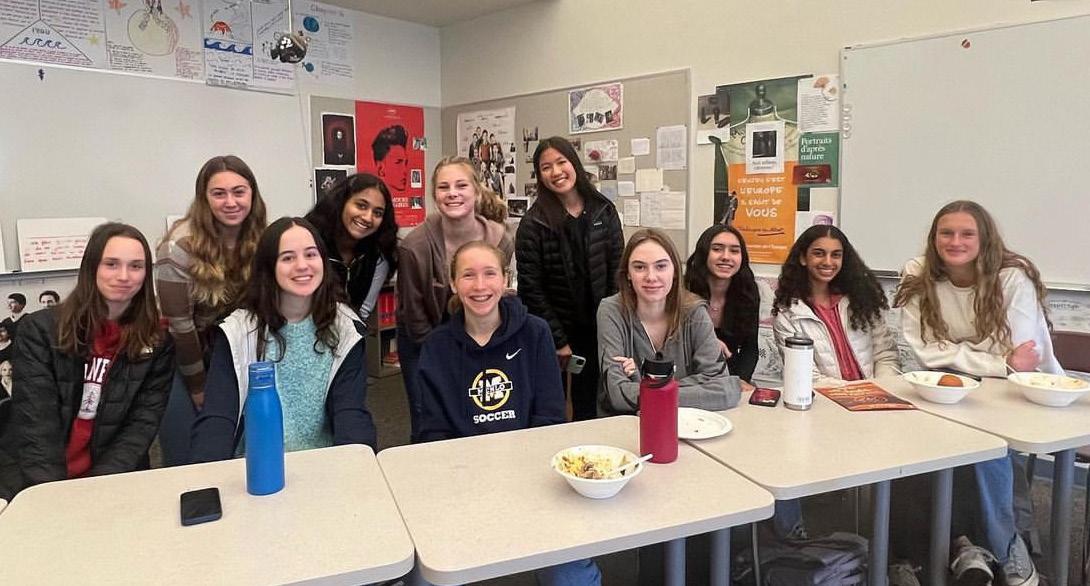
GLI co-leader and sophomore Avani Ganesan said.
IGNITE is another club focused on women in politics; they meet to discuss and debate current political events, as well as promote female leadership through helping group members set up LinkedIn profiles or crafting resumes.
While these groups hope to empower female students on campus throughout the year, the library highlights the contributions of women through their display of biographies and memoirs about important female figures. The library also
something like a display that highlights voices that students or faculty may otherwise not have seen,” Head Librarian Brittney Otero said. “I’m hoping that seeing a display makes someone want to pick up a story either by or about a woman.”
During the month, students were also prompted to write the names of women who have inspired them on a whiteboard pillar in the library, another way Otero hopes to promote conversation about women’s achievements. “There are important women figures throughout history, but then also in our own personal lives,” she said.
can do anything themselves,” she said.
In the present and in the future, Tam hopes to see more women join fields that men often dominate. “We’re always trying to get more women involved,” she said. “I hope to see women feel like they’re encouraged to speak up and have authority as well.”
exhibits fiction books written by a diverse group of female writers. “[The library] is just a really great communal place to see
Otero hopes that the library’s celebration of Women’s History Month will inspire girls on campus. “I hope that they see [the display] and realize that they
While March may be designated to celebrate women’s history, to Otero, the month is also about what women will achieve in the future. “It’s really important to show that we as a community, we really value women’s voices, we want to uplift them,” Otero said. “Each year there’s some new achievement or accomplishment that a woman has achieved, and it’s never going to stop, and I love that we just constantly keep uplifting it.”
With over a year since the beginning of the war between Ukraine and Russia, the conflict has had many implications for both countries as well as the foreign powers involved. On Feb. 24, 2022, Russia invaded Ukraine. The ensuing war has led to millions fleeing from Ukraine, hundreds of thousands of deaths and billions of dollars worth of property damages. At the moment, Russia controls one-fifth of Ukraine’s territories, but Ukrainian forces have held strong in the capital city Kyiv and neighboring towns.

The Russian military has targeted civilian areas in an attempt to terrorize Ukraine into submission. “Those tactics [of] targeting
civilian populations continue. [...] One doesn’t hear about it as much, which doesn’t, by any means, mean that it’s not happening,” history teacher Sabahat Adil said. “I think to some degree, the strengthening, or flexing, of political muscles by Russia, to me, aligns with how different parts of the world right now, like authoritarian governments, are not feeling as held down by codes of international conduct, and they’re feeling more brazen to act in ways that would allow them to gain power.”
However, with the dangerous landscape in the region, it can
be challenging for Ukrainians to leave. “These are people who are living ordinary lives like anybody else and then all of a sudden they’ve had their whole lives turned upside down,” Adil explained. “It’s also hard if you are given the opportunity to leave, because then, you have to create a whole new life for yourself.”
With Ukraine receiving aid from a host of different countries including the United States and the European Union, the regional conflict has had a significant global effect. For example, according to the Associated Press, the war in Ukraine has sparked a new arms race mirroring the Cold War. In an Associated Press article, Patrick Bury, senior lecturer in security at the University of Bath, remarked that many assumed militaries would be less reliant on tanks or artillery and focus would be shifted to more advanced warfare; however, the war in Ukraine seemed to change that viewpoint. “It is, for the moment at least, being shown that in Ukraine, conventional warfare — stateon-state — is back,” Bury said.
“The battlefield in Ukraine right now, today, is starting to look like a meat grinder,” history teacher Charles Hanson said. “The tanks are newer, and bigger, and faster and more modern, but it is still basically trench warfare. It’s basically a war of attrition, [a question of] who can replace the men and the bullets fast enough.”
Not only has warfare reverted back to its old ways, but so have international alliances. A wide range of countries have banded together in their sanctions of Russia. “The EU is taking sanctions,
quite serious sanctions, in the way that it should,” said Michael Clarke, former head of the Royal United Services Institute think tank, according to ABC News. Despite this, according to the Associated Press, more pressure will be put on Western alliances as the war continues. As stress is applied to alliances, changes are beginning to occur. “I definitely feel like there is a shift in the world order,” Adil said.
History teacher Sabahat Adil
The war itself has pointed out many deficits on the European system. Hanson explains how the Ukraine crisis has highlighted their reluctant reliance on U.S.’ military strength. “Well, guess what [the Europeans] found out? They are still relying on the American military for basic security,” Hanson said. “Understandably, it doesn’t feel great, 70 years, 80 years, after the Second World War, to still be relying on the Americans. [...] The Europeans have found out, ‘Well, we do rely on the Americans, and it’s going to cost us a lot to defend ourselves.’”
I hope that they see [the display] and realize that they can do anything themselves.
Head Librarian Brittney OteroIllustration by Maya Stone The Girls Learn International Club is one of many spaces designed to uplift female voices at Menlo. Photo courtesy of Mia Monsalve
Authoritarian governments are not feeling as held down by codes of international conduct.
Adolescents between the ages of 13 and 18 should sleep for eight to 10 hours every night, according to the Centers for Disease Control and Prevention. However, a 2015 study by the CDC revealed that seven out of 10 high schoolers do not meet this requirement. While some Menlo students prioritize a good night of sleep, others stay up late in order to study or complete various assignments. However, not all students are aware of the risks associated with sleep deprivation, like sleep debt.
Sleep expert Dr. Mark Rosekind emphasized that the amount of sleep you need depends on your own needs, and a statistic or number can’t always dictate that. “How much sleep you individually need is actually based on the number of hours a night that allows you to be wide awake and alert throughout the entire day,” Rosekind said.
Children and adolescents who do not get sufficient sleep have a higher risk of long-term health issues, poor mental health and problems with attention and behavior, according to the CDC. “You need to think about sleep as a vital biological need,” Rosekind said. “You need food, water and air to survive. You need sleep to survive. [...] [Sleep] is a secret weapon for you.”
Sleep debt is a phenomenon that occurs when someone does not meet their sleep needs for a prolonged period of time. For example, if a student sleeps six hours a night but needs at least eight hours, then their sleep debt would accumulate to 14 hours after only a week. Sleep debt drags out fatigue and lack of energy from previous nights of sleep. Additionally, it increases the chances of health and behavioral problems. According to Rosekind, it can take several days for an individual to settle out of their sleep debt.
Sophomore Jacqueline Larsen prioritizes a good night’s rest and typically sleeps nine to 10 hours on school nights. Larsen believes that when she doesn’t reach this goal, she faces the repercussions of sleep debt. “If I don’t get [as much] sleep one night, then the next night, even if I get a regular amount of sleep, I still feel tired,” Larsen said.
According to Rosekind, many teens
biology working against you,” Rosekind said. “You can’t switch that.” According to Rosekind, it is okay for teenagers to go to bed later, as long as they are able to sleep in the next morning.
sleep deprived take a nap between 40 and 45 minutes. A longer nap causes people to go into deep sleep, counteracting these benefits; a person who wakes up from deep sleep might experience a phenomenon called sleep inertia, causing disorientation and drowsiness. Sleep inertia also impairs one’s cognitive and motor performance.
Rosekind adds that even if someone only has time for a nap shorter than 40 minutes, it is still beneficial and can help reverse sleepiness. If time permits for a long nap, it should be about two hours because it will get the person through a full rapid eye movement cycle, including deep sleep. However, longer length naps should not be closed to one’s bedtime.
not going to really benefit you,” Larsen said. “I think the better option is just to go to bed so you can retain the information you’ve already studied that night.”
also find it difficult to go to bed and wake up early, and are instead inclined to late nights and sleeping in. This is caused by an internal clock in the brain, called a circadian clock. A circadian clock tells an individual when they should sleep at night, however, throughout puberty, this clock starts shifting to later and later times. Despite needing eight to 10 hours of sleep, teenage brains want their bodies to go to bed later at night. “It’s your

Freshman Zoe Zdrodowski does not stay up late and instead goes to bed around 9 p.m. and wakes up at 6:30 a.m. every day. “My mom’s a child sleep therapist, so she’s kind of ingrained in me a routine and early sleep,” Zdrodowski said. “I also find I need a lot of sleep compared to most people.” While her mom has emphasized the importance of sleep to her, she goes to bed early by choice because she feels better the next day. When Zdrowdoski does not achieve her desired amount of sleep, such as at a sleepover with friends, Zdrowdoski faces the repercussions the next day. “I’ll be more cranky or just definitely feel more tired during the day.”
Rosekind is a strong proponent of naps, as they can improve an individual’s performance and alertness. In a study he conducted for the National Aeronautics and Space Administration with the Fatigue Countermeasures Program, Rosekind discovered pilots who took a nap while on shift demonstrated a 34% increase in performance, as well as a 54% improvement in alertness.
Rosekind recommends people who are
While many teens believe the reason they do not get enough sleep is because of too much homework or too many extracurriculars, Rosekind believes that most teenagers’ issue is actually time management more than anything. “The reason people cheat on sleep is that they’re trying to get more hours into the day,” he said. “But you only get 24.” Rosekind recommends teenagers prioritize planning their sleep schedule first, before mapping out other daily obligations.
Larsen agrees that sleep takes priority in her day, and suggests that others try to adopt a similar mindset. “If you’re deciding between studying a few more hours for a test or getting better sleep, honestly, the studying that you’ll do while you’re staying up and while you're tired is
Sophomore Tony Dokanchi gets around five to six hours of sleep on the weeknights and deals with the consequences daily. “Most of the time, I don’t think I’m functioning at full capacity,” he said. Dokanchi often has enough time to get eight or so hours of sleep but struggles to fall asleep in time. He admits that if he had better time management and got his work done earlier, he would be able to sleep more. “I wish I could fall asleep faster, and I wish I could get my work done earlier,” he said. “Part of that is [my] responsibility and my own time management and part of that is things that are unavoidable.”
You need sleep to survive. Sleep is a secret weapon for you.
I don’t think I’m functioning at full capacity. “Sleep expert Mark Rosekind
only marker of your success,” she said. College counseling also plays a large role throughout applications. Although many students opt to work with private counselors from outside of Menlo, according to Weiden, she had a great relationship with her Menlo counselor,
Elena Wong. “I met with [Ms. Wong] on a weekly basis, probably more frequently than other students,” Weiden said. “She gave me great advice.”
Associate Director of College

Counseling Kristen Jurgens wants Menlo students to take classes that interest and challenge them on the road to success. “A common misconception is that you need to have all A’s to go to college,” she said. Jurgens also encourages underclassmen to focus on enjoying their high school experience at Menlo. “The most important thing is that you focus on being in high school,” she said. “We don’t want high school to be about college.”
 by KAYLIE WU
by KAYLIE WU
Q: As a songwriter, what was the first song you wrote?
I don’t remember because I was like five. But my first EP of songs, which is on Spotify, is the first group of songs that I wrote. “Imperfections” was maybe one of the [first] ones that I wrote.
Q: What was the best song you wrote?
I think my favorite song that I’ve written is “Angels,” which I released during quarantine in 2020. Or “Quarantine Christmas.” And then my favorite favorite songs are the ones that I haven’t released yet that I’ve written recently.
Q: Are you going to release the recent songs?
No, they’re for me.
Q: How do you write a song? What does that process look like?
If I’m listening to a song or see a TikTok about something cool, I think, ‘Wait, that was a really cool lyric, I feel like I can make a whole song out of just that one metaphor.’ And then I start writing lyrics first. Then, I pull out my guitar and

choose a chord progression, so I can put the lyrics to the music.
Q: Who’s your favorite artist?
My favorite artist is Baby Keem, which is really funny. It’s just ‘no thoughts’ music.
Q: If you could visit one place in the world, where would it be?
I really want to go to Italy. I’ve never been there.
Q: Where do you envision yourself 10 years from now?
Probably being a doctor. I want to live in a big city. Maybe I’ll be back here in San Francisco. Maybe I’ll try LA, maybe Boston. Who knows?
Q: What excites you the most about going to college in New York?
All of the musical experiences. Going to Broadway shows or random jazz clubs. I want to see cool people perform.
Q: What’s your In-N-Out order?
I get a plain cheeseburger usually, and
then fries [because] I love fries.
Q: If you were stranded on an island, what three items would you bring?
Probably rope... water... can I say Gabe [Stankovich]?
Q: Selena Gomez or Haley Bieber? Selena. I follow Selena on Instagram.
Q: Is it acceptable to fold pizza?
Yeah. But I don’t think it’s acceptable to eat pizza with a fork and knife.
Q: Is In-N-Out overhyped?
No. I don’t think it’s better than any burger place, [but] I think any burger place that’s better is more expensive. And also In-N-Out’s open late.
Q: What’s one non-required Menlo class that you think every student should take?
Dance. I really love Dance. A lot of people there have never danced before, but it’s just really fun, and you get to be with the most random people in class. It’s
such good vibes because Angela [CurottoPierson] is so nice.
Q: What’s something that most people don’t know about you?
I’m Canadian. I was born there and I have a Canadian passport. I’m a dual citizen.
This process has made me realize that, at the end of the day, you can go to any college and be successful.
Senior Sydney Fish
“It was probably the institution that changed my life more than anything else. I went to a good college. I went to a good graduate school. But it was Punahou that really gave me the tools that I use in the world,” Head of School Than Healy said.
Healy’s father served as the school principal at the Punahou School in Honolulu, Hawaii. Therefore, Healy attended the college preparatory institution from second to 12th grade. According to Healy, his experience at Punahou shaped his future as both a person and educator.
Healy has undergone a full-circle journey from student to head of school. While grateful for those who have helped him along his path, Healy attributes much of his success to his high school education, especially the ethical side of his experience.
Dating back to 1841, Punahou originally served as a school for the children of missionaries who served throughout the Pacific region; as a result of this, the school upholds many traditions, including religious practices, to honor its culturally rich past.
Healy argues that Punahou balances religion with ethical education.
“[Punahou] wasn’t dogmatically religious,” Healy said. “It was more secular, and so there was good there and it was reflected in the culture. That helped me find my own values.”
Referring to his own academic and athletic aptitude while at Punahou as “middle of the pack,” Healy believes that the more integral part of his time there was his acclimation to the school’s values. “It’s the values that exist there: the grace, the humility.”
During the pandemic, Healy thought about the concept of kuleana, the Hawaiian word for responsibility. He attributes his understanding of this to Punahou’s devotion to value-based learning. “[It means] you are responsible [for] the community because the community will take care of you, so the care needs to go both directions,” he said.
Healy compared the mainland culture of responsibility to Hawaiian culture. “In my observation, American culture often defines “responsibility” in relation to the self,” Healy said. “In Hawaii, probably because the culture was developed on a set of islands where interdependence not only with each other but with the land was vital for survival, the definition of responsibility is much less about the self and much more about mutuality.”
The pandemic and its effects further highlighted his observations. “When the pandemic hit I observed the culture in America responding in ways that
defined responsibility to the self: ‘I have a responsibility to keep myself and my family safe’ or ‘I have a responsibility to preserve freedom and choice for myself and my family,’” Healy said. “While I certainly see and empathize with this orientation, the concept of kuleana leads us to a slightly different definition with powerful implications in a crisis: my responsibility is to a larger community not because it is the ‘morally correct’ thing to do but because if individuals work to keep a community healthy, the community will then contribute to the individual’s health.”
they’re always looking to what will be. That’s a pretty significant cultural nuance.”
Despite that difference, Healy is determined to build on Punahou’s approach. He wants to ensure that Menlo students emerge from the Upper School with a strong sense of self-identity rather than solely focusing on their life or career goals. “How the heck are you going to know what you’re going to be when the world is changing as quickly as ours?” Healy said. “We can’t put it on kids and say, ‘Hey, you’re 18, tell me where you’re going to be when you grow up.’
It’s an impossible and frustrating question to ask, and is frankly, unfair.”
gone on to become the president of the United States.”
In 2010, Obama invited Healy’s father — who served as principal during Obama’s time at Punahou — along with
Healy also contrasts the cultures of both schools, highlighting the differences in tendencies of the larger areas surrounding the schools. “[Punahou] looks to the past to

Healy supports his argument — that students as young adults don’t need to know what their future holds but rather should be focused on their values
— by discussing former president, Barack Obama, who graduated from Punahou in 1979. Healy was a fourth grader when Obama was a senior and remembers watching him play on one of his favorite State Championship basketball teams. “Obama was a student, that at Menlo, we would have looked at and said, ‘This student is struggling,’” Healy said. “[He was] unmotivated, unfocused and ran with the wrong crowd. Underachiever. A benchwarmer on a really good basketball team. He was a very talented player, but he wasn’t very coachable.”
Healy and his daughter to the White House where they spent time together in the Oval Office. “Obama’s telling my daughter, ‘You know, your grandpa did his best to keep me on the straight and narrow, and I made it really hard on him, but it made all the difference in my life,’” Healy said. “It was a pinnacle moment for my dad and a pinnacle moment for me.” The foundational skills and values Obama learned in high school set him up for success in what Healy refers to as “the ultimate leadership position that requires character.”
In the future, Healy believes Menlo could focus more on ethical and moral values, similarly to Punahou. “I want to focus on who you are, your skills and how fluid those skills are. How broadly can you apply them?”
Healy said. “I think we do it well, but we do it more passively. There is an argument to be made that we could do this more explicitly.”
Healy is constantly reflecting on his journey as an educator. “As teachers and as leaders, one of the ways we learn how to teach and lead is through our role models,” he said. “I [have] had some tremendous role models for how to teach and lead in my life — that’s part of my DNA, that’s core to who I am and how I do my job.”
inform them about what direction they should go in the future,” Healy said. “In Silicon Valley, that’s not the orientation. People [here] don’t look to what’s been,
“But the truth is that we’re not really defined by who we are at 18, or 17 or 16,” Healy said. “No one on the planet would have guessed that that student would have
He also wants Menlo to continue to teach students from an ethical and moral standpoint. “How do you lead from a place that values differences of every kind, that sees beauty in cultures that are not your own?” Healy said. “That’s what I got from Punahou.”
“
Arts & Lifestyle March 30, 2023 7
Staff illustration: Michele HratkoPeople don’t look to what’s been, they’re always looking to what will be.
“
After attending 40 hours of both regular driving school and behavior management driving school, where participants learn how to cope with road rage and other skills, Stone is a more careful driver. “I don’t have anger management issues, so I don’t think I took anything away from that [course] because I’m not an angry driver,” Stone said. “However, I definitely pay more attention to the speed limit while driving.”
A senior boy, who asked to remain anonymous, recently got his license suspended for a month after a traffic violation this summer. While driving between his friends’ houses at night, the boy rolled through a stop sign at around 20 mph.
A police officer quickly appeared behind the senior and trailed him for several hundred yards before pulling him over. As soon as the boy rolled down his window, the officer immediately asked if the driver had recently consumed drugs or alcohol.
Although the senior was fully sober at the time, he did have marijuana in his car. “As the officers were coming over, they had seen [the marijuana], and they also had smelled it a little bit in my car,” the senior said. With probable cause from the marijuana sighting and odor, an officer took the senior out of the car and patted him down while another searched his car.
and from school and work. Nevertheless, the senior disregarded the punishment and continued driving his friends around for fun. “My parents were aware of this, but they knew that it was my risk that I was taking. If I did get caught again, then they knew that I would get my license taken,” the senior said. “And then that’s my fault. Right? So they were aware of that and let me do that.”
whatnot,” Perez said. “But he ended up giving me a citation, or like a ticket, with a notice to appear in court.”
Perez appeared in court via Zoom a few months later and, as a minor, was accompanied by his father. Initially, the judge tried to suspend Perez’s license for 30 days but agreed to let Perez write a three-page essay instead.
Even though the judge agreed to reduce the punishment, both Perez and his dad felt that the judge was unnecessarily rude throughout the encounter. “I also didn’t help my case because, basically, he asked at one point what school I go to, and I said Menlo. Then he proceeded to ask my GPA, and I just said, ‘Do I have to legally answer that?’ Because like, I didn't want to tell him my GPA,” Perez said. “I feel like that was kind of personal and not his business. Yeah, it doesn’t seem really related. I think that kind of pissed him off a bit.”
few jokes,” Miller said.
According to Miller, driving with the correct paperwork and being prepared when answering questions also can make a big difference. “One time I got pulled over, and I didn’t have my license on me and that didn’t end well,” Miller said. “I also think cops, especially in this area, really like teaching kids a lesson for some reason, so they tend to act mad and scary, so crying and showing you’re sorry for
Senior Sophie Stone
Even though the senior disobeyed the restriction, he still feels he learned a lesson from the experience. “It definitely did make me more cautious about my driving, and just how I act with my car, like, I think now I’m a lot more responsible with it, especially what I put into my car while I’m driving it,” the senior said. “I was just antsy [the night I got pulled over], and I kind of overstepped that and lost a bit of control, and I think as of now I don’t make those mistakes that much anymore.”
Perez felt that the judge’s demeanor prevented him from taking away a positive lesson from the court experience. “I think it was negative because the judge was kind of rude and mean. I feel like if I had gotten a [judge] that was actually trying to make me understand why [distracted driving is] really bad and why I really shouldn’t do it again, rather than just trying to dig at me and whatnot, I think I would have understood it more,” Perez said. “He was more trying to just dig at me as a person, and he tried to dig at my parents for how they’re parenting and whatnot.”
speeding or whatever can really help.”
Since the senior was a minor, the officers called his parents and explained the situation to them. The police also agreed to let the senior’s parents handle the drug possession issue with their son and only issued a citation for running the stop sign.
A few months later, the senior boy and his mom logged onto a traffic court Zoom. “I came in there knowing that I had done wrong, and my parents had definitely punished me for [the marijuana] separately,” the senior said. “But the judge was also going really strong at us and going really against my mom as well, which I think is unfair. It was my mess up. It shouldn't be my parents’ fault.”
The judge ultimately decided to restrict the senior’s license for a month, meaning he could legally only drive to
Senior Will Perez similarly appeared in Zoom traffic court after being pulled over for scrolling on his phone while at a red light earlier this year. “I didn’t think being on my phone at the red light was that big of a deal because I had been stopped [at the light] for a while, so I thought it would just be a quick interaction [with the officer] or
Junior Paige Miller has also had stressful interactions with police while driving and believes that, in most situations, the officer’s and driver’s attitudes make a huge difference. A few months ago, Miller was driving 15 mph over the speed limit when a police officer
According to Miller, traffic stops as a teenager usually ignite fear because there are additional pressures when driving with a provisional license. “It’s also pretty scary because if it’s after 11 p.m., and you’re driving with other people and you’re getting pulled over for something, that right there is three infractions in itself, and then there goes your license,”

It was my mess up. It shouldn’t be my parents’ fault.
He was more trying to just dig at me as a person, and he tried to dig at my parents for how they're parenting and whatnot.
Senior Will Perez
I had to go to regular driving school and behavior management school.
“Dear Lord, the battles we go through life, / We ask for a chance that's fair / A chance to equal our stride / A chance to do or dare
/ If we should win, let it be by the code, Faith and Honor held high / [...],” the Husker Prayer reads. For the last two years, as a member of the varsity football and varsity boys lacrosse teams, I have chanted the “Husker” before every game. While the prayer seemingly emphasizes religion, the passionate chanting has never felt like a religious imposition. Nearly every player on the team huddled close together and recited it in unison before a game began, ending with emphatic cheering to energize the team.
The prayer originated as a pregame ritual for the 1994 national champion Nebraska Cornhuskers football team. According to the Nebraska Athletics website, the ritual motivated players who aimed to win a national title after a missed last-second field goal ended the Husker’s season the previous year.
Despite the allusion and direct address to a god, the website does not mention a religious focus, supporting its identity as more of a pregame hype speech. As a non-denominational school, Menlo’s administration separates religion from classroom activities and athletics. This clear distinction makes a subtly religious prayer like the Husker come off as a simple team tradition.
Junior Mikey McGrath identifies as Catholic but
believes the Husker remains non-denominational. “I don’t think that it is actually about religion; it’s more about the values that the Husker prayer talks about,” McGrath said. “If you’re not religious, you can still participate in it, and I don’t think it’s very exclusive.”
Much of the pregame rituals and prayers are left to the player’s discretion, and McGrath believes it should stay that way. “It would seem more forced [if led by the coaches],” McGrath said.
Despite this separation, Menlo is a “supplemental member” of the West Catholic Athletic League, a CIF Central Coast Section league composed primarily of nine schools. All nine full-time member schools are religious, and their athletic teams compete primarily in the WCAL. Menlo and Sacred
The WCAL never pushed a Catholic agenda back to Menlo that I could detect, but things were different at this meeting. Each school sent a representative from every team involved in the league, leaving me as the only Menlo student in attendance.
“As members of the West Catholic Athletic League, let us pray...,” the WCAL leadership said to us at the beginning of the summit.
As a non-Catholic representing the only non-denominational school, I felt out of place. I surveyed the room as everyone lowered their heads into their hands, closed their eyes and followed the prayer.
Heart are the only supplemental schools competing in the WCAL in a select few sports. The boys and girls water polo and boys lacrosse teams are all members of the WCAL because Menlo’s primary league, the WBAL, does not have enough schools that sponsor these sports. “We saw a good fit in the WCAL, and they were willing to grant us affiliate member status and welcome us to the league,” Director of Athletics Earl Koberlein wrote in an email to The Coat of Arms.
As a four-year lacrosse player, the Catholic variable wasn’t important to me until I attended the WCAL Spring Sportsmanship Summit on Feb. 15.
Aside from awkward glances around the room, to which nobody met my gaze, the sequence didn’t impact me much. However, the leader continued to focus on the role of religion in sports and the league overall to a degree that I found fairly distant from Menlo’s values and identity.
This is, however, in accordance with the WCAL goals listed on its website, “to promote the student-athletes greater appreciation of his/ her spirituality by fostering an understanding of athletic competition within a Christian context.”
In short, Menlo sacrifices a slight sense of religious independence as a member of the WCAL. Fortunately, the religious practice ended when I left the summit, and I haven’t experienced it again in any form.
Less than half of U.S. adults belong to a religious congregation, according to a 2021 poll from Gallup. This trend of fewer people connecting with religion can be seen at Menlo as well. While some students may come from religious backgrounds, they don’t always believe in God as individuals.
Sophomore Ari Kaufman, who grew up conservatively Jewish, still identifies with Judaism even though she doesn’t believe in God. “I still consider myself Jewish because I like a lot of the values that the Jewish religion covers,” Kaufman said.
“I don’t believe in God just because I’m very much a logical,
visual thinker, and I can’t see or I can’t really envision a higher power.”
Kaufman was able to balance her connection and questioning of Judaism after a lesson with her rabbi in preparation for her bat mitzvah. The rabbi asked the students to raise their hands if they didn’t believe in God. “I was the only kid who raised [my] hand, and my rabbi raised his hand as well,” she said. “To this day, I’m not actually sure if he agreed with it, because it was less about believing in God and more that the idea of questioning religion is so prominent in Judaism.” To Kaufman, this experience symbolized that one doesn’t have to believe in God in order to be Jewish.
Senior Reese Weiden echoed a similar sentiment. “There [are] a lot of other core values of Judaism that can make you Jewish, and a belief and servitude to God do not need to be one of those,” Weiden said. Weiden’s parents are Catholic and Jewish, and she attended a Catholic school from preschool through elementary school.
“I grew up thinking that Catholicism was what I was supposed to do,” she said. After a close friend of hers died when she was a sophomore, Weiden stopped believing in a god.
“I was like, ‘How could this happen?’ I [was] praying, and nothing,” Weiden said. Now, Weiden considers herself agnostic, meaning she believes the existence of a higher power is unknowable. “I don’t think we can prove whether or not there is a God,” she said.
Senior Helen Barkley is also agnostic, despite being raised in a Roman Catholic
family. Barkley had her christening, first Communion and confirmation. “I still see myself as a part of the church because I appreciate the values it brings to people and just as a family tradition, but I’m not set on the idea of a higher power,” Barkley said.
The church Barkley attended on Sundays with her family frequently discussed the importance of “loving your neighbor” and helping others, something Barkley still carries with her today. “I still have a lot of appreciation and respect for the church; it’s instilled in me a set of good values,” she said.

Kaufman tries to take ideals from her religion into her life as well. One of these ideals is mitzvot, commandments outlined by the Torah, which has taught Kaufman to do something good each day. “Taking time to actively think about doing something kind is sort of how I connect to my religion and implement it into my daily life,” she said.
Kaufman finds that, in a way, not believing in God brings her a sense of reassurance. “I find it more comforting thinking I’m in control of my life as opposed to some higher power being able to push these buttons that change things,” she said.
Kaufman acknowledges that one’s relationship with religion can be ever-changing, stating that her own religious ideals may shift again in the future. “Something could happen in my life and I feel like there is a higher power with some influence,” she said. “Where I am right now, I’m pretty solid in my beliefs. A lot of things are fluid, and I think religion falls into that category as well.”
"While the prayer seemingly emphasizes religion, the passionate chanting has never felt like a religious imposition."
"I’m very much a logical, visual thinker, and I can’t see, or I can’t really envision, a higher power."
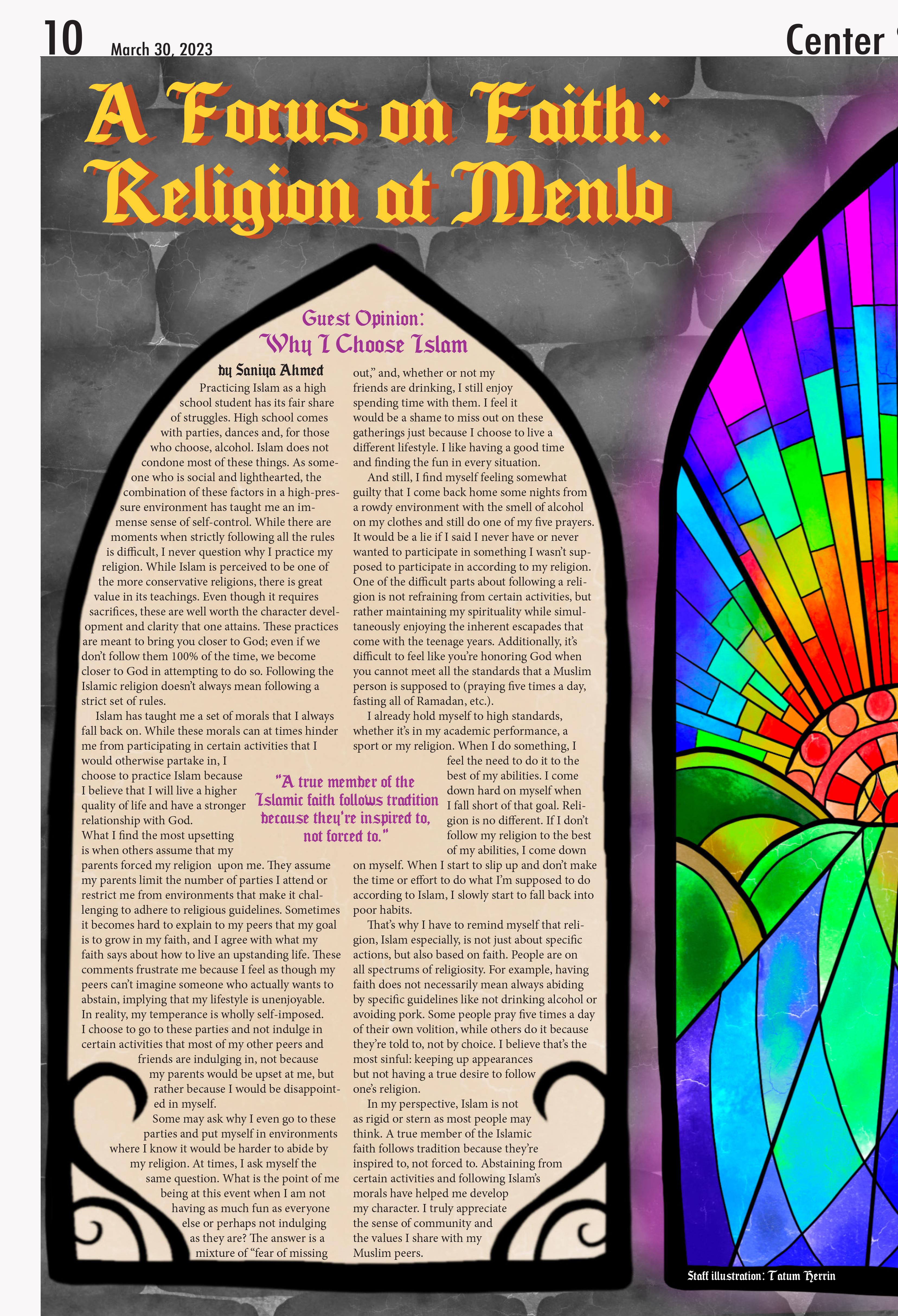
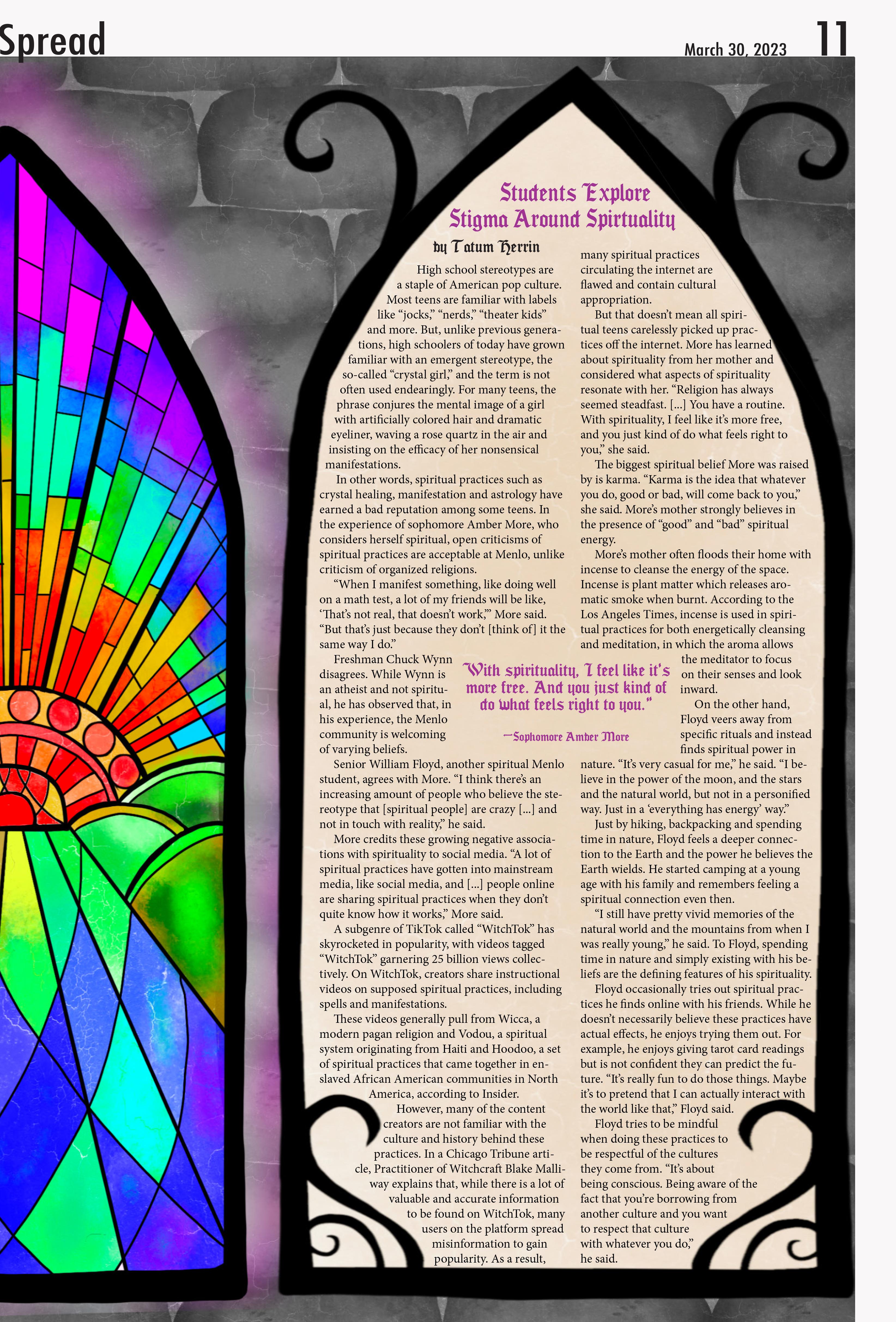
For religious students at Menlo, certain aspects of high school — party culture, rigorous classes and time-consuming extracurriculars — can impact their relationship with their religion in both positive and negative ways. Sometimes, recreational activities can conflict with established religious viewpoints. Menlo’s emphasis on academics can lead students to prioritize academics and extracurriculars, detracting from the time and energy that they are able to dedicate to their religion.
Junior Kylie Jones, a Presbyterian Christian, finds it challenging to strive for the same goals and ambitions as her peers while also sustaining a consistent dedication to her religion.
“There is that guilt aspect, for sure, but also, these are the choices that I’ve made,” Jones said regarding her prioritization of school over religion. “I don’t need to fill my schedule, that’s not a requirement for being at Menlo, and [I] don’t have to take hard classes because they give the option for regular ones. So all of it has been my choice, and I feel guilty about that because I know it's a personal choice.”
Junior Willis Johnson shares similar sentiments toward balancing religion and a busy schedule. Johnson, who is Mormon, can find it tough to wake up and go to morning seminary classes through the Church of Jesus Christ of Latter-Day Saints to study the religious scriptures. It can be difficult for Johnson to wake up early to attend seminary when he is tired from schoolwork or football practice. “Some-
times it’s hard for you to make the decision to go to church because there’s other stuff you need to attend to, so I think that academics and extracurriculars definitely can take away from religion,” Johnson said.
Last year, when freshman Matthew Franc was in eighth grade, he had Sunday school to prepare for his Confirmation built into his weekend schedule. This year, he finds it difficult to attend church on the weekends when he also wants to get homework done or do other things. “It's just, it's hard to be able to commit to, you know, going to this place at this time for church,” Franc said. However, Franc makes an effort to pray most nights.
Religious ideals can also conflict with the high school culture of partying with alcohol and drugs. Religions such as Islam, Mormonism and Pentecostalism prohibit the consumption of alcohol and other substances. This can cause a dilemma for teenagers who practice these religions and may encounter substance use throughout their time in high school.
Johnson finds that he feels pressure to both remain dedicated to his religion and follow its rules, but there is also the pressure to fit in at school. While Johnson sometimes experiences guilt for going to parties where illicit substances are present, his guilt is often relieved when he repents on Sundays, feeling able to start anew.
Students’ religions, however, can provide them with an outlet in the face of the stresses of busy schedules and expectations. “I feel like when I do go to church, it does relieve some of that stress because it kind of places the value on you just as a reflection of God’s image and a human being rather than just your accomplishments [...] in school and everything,” Jones said. Johnson also appreciates having somewhere to go, someone to trust and the ability to pray when he has a problem or simply needs to talk.
Presbyterianism places less emphasis on restricting certain substances which makes party culture less stressful for Jones. However, having friends of other religions who do not drink or use other substances has made it easier for Jones to make the personal decision not to partake in drug or alcohol consumption.
One part of her religion that Jones does believe may be challenged in the future is its sexual beliefs. “This is probably a bigger issue for some other people because I haven’t really engaged in a serious relationship, but with our sexual beliefs and everything, that’s a huge part,” Jones said. “I haven't gotten to that point yet, but I’m sure it will come and that will be extremely difficult.”

Even though Menlo is not a school with a religious affiliation, there is still a religious presence on campus. Along with these religious identities come stereotypes, offensive assumptions, harmful jokes and other forms of judgment for some students.
Sophomore Miraal Zaki is Muslim and is one of only 250,000 Muslims in the Bay Area, accounting for 3.5% of the total population, as noted by the Bay Area Muslim Study conducted by Santa Clara University. Due to the small Muslim population, Zaki feels that some people in her area are uneducated about her religion, leading to potentially offensive remarks being made about Muslims. “I’ve gotten terrorist jokes before,” Zaki said. However, Zaki believes that these comments often come from a place of ignorance, not hate. “It’s nothing extreme. Everyone tries to be respectful and learn about [Muslims]; sometimes they just don’t realize that their words have an impact,” she said.
Zaki and her family celebrate Muslim traditions such as Ramadan and Eid. Ramadan is a month-long period in which Muslims all over the world fast from sunrise to sunset for a month. At the end of thirty days, there is a celebration called Eid. The holiday allows those who participate to recognize their privilege and realize the importance of helping others.
Muslim families like Zaki’s donate a percentage of their earnings from the month to charity.
Zaki is currently reading a book for her Honors U.S. History class at Menlo called “Innocent Until Proven Muslim” by Maha Hilal. Reading the book has helped her realize how fortunate she is to live in an area where she is not subjected to overt discrimination. Regardless, she still finds it problematic that people at a school as progressive as Menlo make jokes about her religion and treat it so lightly. “While I’m lucky enough to have a safety blanket, most people don’t, and not acknowledging that is a huge issue,” she said. “I have that blanket where jokes are made to me fairly often, but not to an extreme level where I'm worried about my safety or well-being at all.”
being tossed around in the Menlo community. “The most common one is someone talking about money or accounting because that is a really common Jewish stereotype that is propagated throughout the news,” he said. “Public figures also propagate some anti-Semitic beliefs.” Still, Deutch doesn’t feel particularly bothered by the remarks. “It’s never anything super serious. I never feel threatened as a Jewish person at Menlo.” Deutch mentions that there is a considerable Jewish population at Menlo, so he is not alone.
Junior Theo Sanders is Presbyterian. His father was raised Catholic and his mother was raised Protestant, so religion has been a part of his life since he was born. He tries to go to Church every Sunday, and he considers religion a big part of his identity. Church has been a place for Sanders to talk to other people about their experiences growing up.
Junior Jackson Deutch is Jewish and a part of the Jewish Affinity Club at Menlo. Growing up, Deutch attended a Jewish sleepaway camp and had a Bar Mitzvah. “The identity of being Jewish is an important part of my life; it’s part of who I am,” he said. Deutch has experienced some Jewish stereotypes
Sanders believes that there is stigma surrounding his religion, specifically regarding Christianity as a whole. “Religiously charged political decisions like homophobia or anti-abortion are something [Christians] do face judgment for,” he said. “People assume if you believe in this religion then it is implied you believe this negative stuff.” Sanders asserts that these beliefs are generalized and not representative of all Christians.
Because Menlo is a secular school, Sanders feels like students who are religious are not in the majority. Sanders thinks the school could benefit from more conversation around religion to dispute the stereotypes associated with them.
"So all of it has been my choice, and I feel guilty about that because I know it's a personal choice.”
-Junior Kylie Jones
“People assume if you believe in this religion then it is implied you believe this negative stuff.”
-Junior Theo Sanders
On Menlo’s teams, many studentathletes decide they want to pursue collegiate athletics, and some go on to be the top in the country.
Sophie Jones (‘19) played Division I soccer at Duke University and was recently signed by the Chicago Red Stars in the National Women’s Soccer League draft in January 2023. Jones was the 2018-19 Gatorade National Girls Soccer Player of the Year and then went on to be a three-time All-Atlantic Coast Conference selection. Cole Kastner (‘20) is a junior defenseman on the University of Virginia lacrosse team where he was named the 2022 ACC Defensive Player of the Year. Simone Adam (‘22) concluded her first season playing volleyball at Johns Hopkins University as the Centennial Conference Rookie of the Year.
Kastner, Jones and Adam are all grateful not only for the ability to play their sports at the collegiate, and even professional level, but to excel in them as
for the classroom but also knowing, ‘I’m not gonna have that much time. How can I manage [my time]?’ and being able to be proactive and speak with teachers in that environment really made the transition pretty smooth,” Jones said.
Adam also felt well-prepared to be a competitive college athlete when graduating from Menlo. One aspect of athletics that she felt particularly ready for was the weight room. “Not a lot of high schools have what we have in terms of a strength program, so I just feel like I was extra prepared on that front,” Adam said.
Kastner had a similar experience. “I would say one of the most important aspects of my mental experience and probably what I’m most grateful for from being a student-athlete at Menlo is [...] just knowing that at any given time, in the winter playing basketball in the spring playing lacrosse, I had [multiple] fantastic coaches, [...] two fantastic teams, tons of good friends and great people to be around, while simultaneously balancing what was pretty rigorous school work,” Kastner said.
Kastner and Adam have also enjoyed keeping up with their Menlo teammates as they pursue collegiate athletics. “Just getting to, like, follow their success has been cool just because we’re all kind of going through it together,” Adam said. Adam also said that she was excited because she almost got to play against her friend and former teammate Kami Israelski (‘22) in the NCAA tournament.
been exciting, but not without difficulties and adversities.
11 games into her freshman year at Duke, Jones tore her ACL. The injury caused her to sit out for nine months and then do physical therapy during the COVID-19 pandemic. According to Jones, this injury was the low point of her collegiate experience, but what came after was “worth it.”
well. Part of this success — who they are as student-athletes in particular — began in their time at Menlo.
Balancing academics and athletics during their time at Menlo prepared these alumni for the challenge of playing for DI and DIII athletics while also succeeding academically at top universities. Jones, in pursuing her goal to play DI soccer and competing at the highest level, missed quite a bit of school when she was traveling for soccer. “[Menlo] really prepared me academically. I think the combination of feeling like I was prepared
“I’m so grateful that me and four of my buddies from my grade in the 2020 class have all been pursuing playing college lacrosse and trying to succeed at the next level,” Kastner said. “To always get to come home, or when I’m with those guys, to be able to continue to push each other and try to progress and become better lacrosse players, athletes, people or whatever it may be is such a fantastic part of my life, and I think part of all of our lives.”
Jones’, Kastner’s and Adam’s experiences as collegiate athletes have all
Throughout the rest of her career at Duke, Jones started in 75 straight games according to Duke Athletics. During this time, the Blue Devil soccer team made it to the Elite Eight three times, and Jones scored the game-winning goal in an NCAA tournament game. In addition to her feats on the soccer field, Jones’ experience playing college soccer was further enhanced by her love for the university and her teammates.
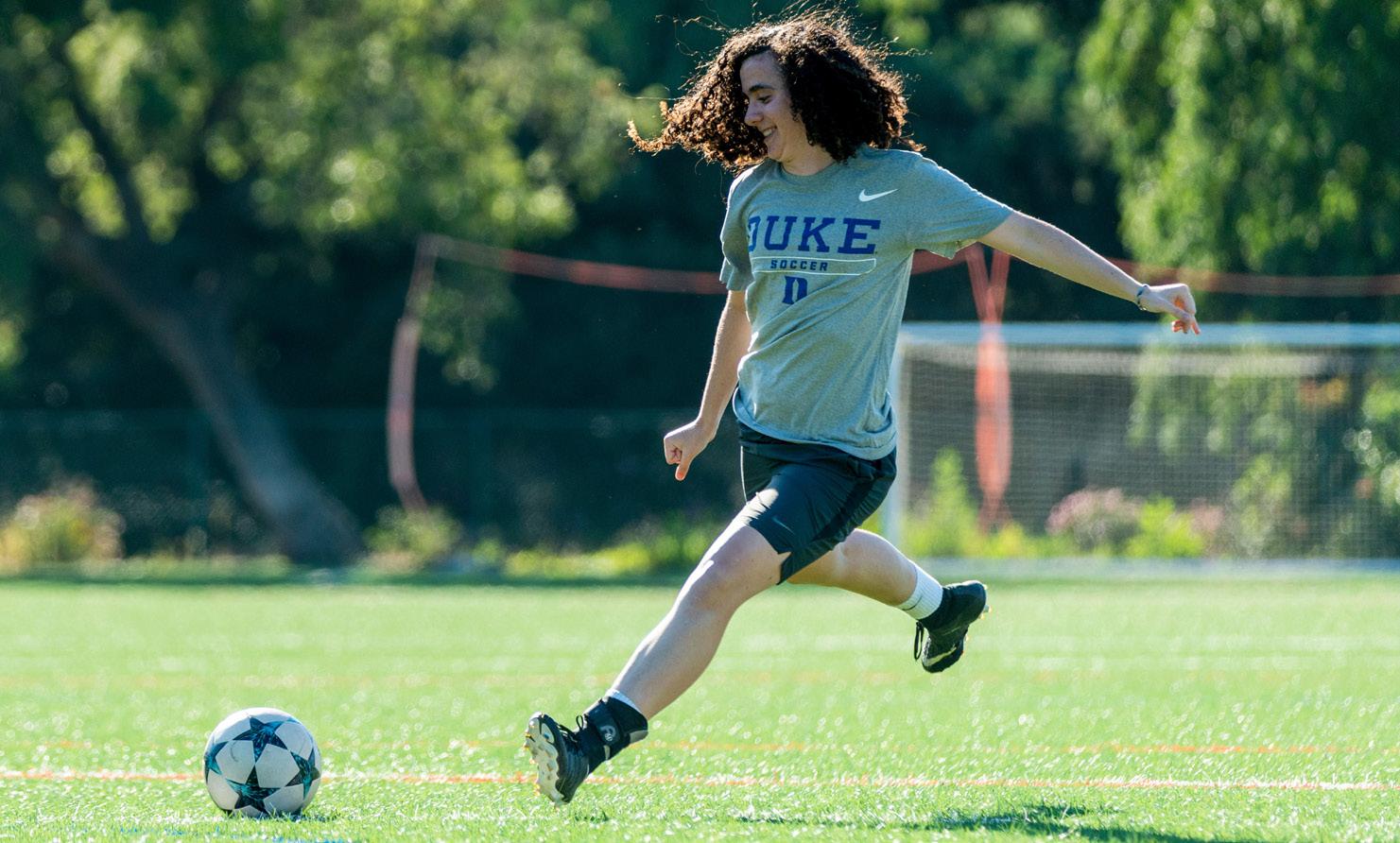
“I mean, [playing college soccer] was a dream come true,” Jones said. “I feel like growing up so close to Stanford, I was going to college soccer games ever since I can remember, so that was always kind of just something I’d hoped to achieve. So to be able to take that next step was super fun and honestly just a great challenge and it made me a better player.”
Jones has been training with the
Chicago Red Stars for a few months now and is about to begin her first season as a professional soccer player. “Getting to play with these players that are so amazing has been a highlight, and I already feel like I’m improving every day just because I’m surrounded by such amazing people,” Jones said. “And it’s just been super fun to just kind of realize that dream of being like a pro athlete.” Jonese hopes to play for as long as she can while still having fun doing it.
Adam played in all 32 of Hopkins’ matches as a freshman outside hitter where she accumulated 414 kills, 97 digs and 45 blocks according to Johns Hopkins athletics. Adam attributes much of her playing to being “lucky” because a number of players graduated in 2022.
Adam’s team made it to the NCAA DIII quarterfinals, which was a highlight of her freshman season. “I’d say getting to travel with the team was just really awesome,” Adam said. “I know we did that in high school, too, but there’s something about, especially traveling for the NCAA tournament, there’s just kind of a big spectacle, and it was just a really cool experience.”
Looking back on her first season at Hopkins, Adam is happy with the school she chose. “I love my team and I’ve really enjoyed it and it's been a lot of fun, so yeah, definitely I’m where I should be,” Adam said.
Kastner’s time at UVA thus far has not only included being the 2022 ACC Defensive Player of the Year, but also winning the 2021 NCAA championship, scoring a goal while playing defense and accumulating the ACC Defensive Player of the Week twice in one season.
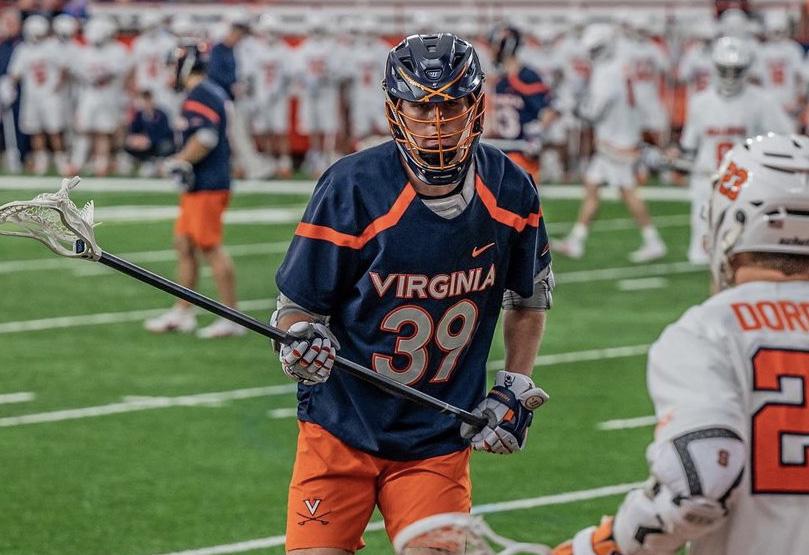
Kastner also keeps in mind a mindset that his parents instilled in him, “To whom much is given, much is expected,” which he believes has allowed him to be successful. According to Kastner, he is lucky to have been put in a good position and to have a support system of parents, coaches and friends, so he tries to make the most of it.
Kastner also advises Menlo athletes to enjoy the memories and relationships “My number one thing is just to play multiple sports,” Kastner said. “It might seem a little counterintuitive at first, but when you play multiple sports, like I was able to play basketball and lacrosse, there’s so much incredible cross-training, there are so many different skills and different ways of communication. All these things end up applying to whatever sport you want to pursue at the next level.”
[Menlo] really prepared me academically.
Sophie Jones (‘19)
At two years old, senior Colin Dhaliwal first threw a baseball around the backyard with his dad. 15 years later, he committed to play Division III baseball at Babson College.
Over the summer, Dhaliwal discovered that Babson would be his top college choice; a few months later, he received word from the coaches that they were going to send him a recruiting offer. Babson officially accepted Dhaliwal in December after he applied on the early decision track.
Dhaliwal fell in love with Babson because it perfectly fulfilled his parameters for an ideal higher education experience: DIII athletics and an elite business program located on the East Coast. Since Dhaliwal is originally from Boston, attending college in Massachusetts is “kind of like going back home.”
Not only did Babson’s academics and location entice Dhaliwal, but so did the team’s atmosphere. “The coaches were awesome,” Dhaliwal said. “I’d love to
In December of 2022, senior Jackson Kay committed to play water polo at the Massachusetts Institute of Technology.
Kay first began playing water polo at the age of nine. “I kind of shopped around a lot of sports, but water polo was the one I grew to love,” he said. At Menlo, Kay was a three-year starter on the varsity team. “I technically specialize in center defender, which I will likely play at MIT,” he said. “But Menlo’s needs were more fluid, so I played a lot of everything.”
In addition to playing water polo at school, Kay competes with the Stanford Water Polo Club as part of their 18A team. Last summer, the team placed 19th in the nation at the Junior Olympics. Kay plans to continue playing for the Stanford club team, this spring and summer in preparation for MIT.

Kay realized that college water polo was for him when he noticed many of his teammates going through the recruiting
play for them, and the program was right and the location was right, so everything kind of lined up into place.”
Dhaliwal also attributes his love for baseball to the Menlo program. Although the pandemic cut his freshman season short, he feels that the varsity team has improved each year. Sports returned for Dhaliwal’s sophomore season, and he’s played on the varsity squad since.

“We had a rough sophomore year just because we were a very young team. Because of COVID, people were playing other sports and we lost some of the juniors and seniors who would have played for us. This year, the baseball team has gotten off to a great start,” Dhaliwal said. “[I’ve loved] my Menlo baseball experience. It’s been a lot of fun seeing everybody grow, but also seeing myself get better and improve.”
Several moments from his time playing at Menlo stand out to Dhaliwal. In his sophomore season, the Knights won only two out of 20 games, so he vividly remembers the team celebrating
their walk-off win against King’s Academy. The next year, the team improved and made it to the Central Coast Section semifinals. Five games into his final season, Dhaliwal’s team held an impressive 4-1 record.
Next year at Babson, Dhaliwal will fight for innings, but that’s what entices him. “When I was talking to the coaches at Babson, their emphasis was that this is a place where you’re gonna have to earn everything you get,” Dhaliwal said.
“I think that’s kind of the mentality I’ve always had [...] I’m looking forward to [...] the pressure of having to go out and chase something that I’ve wanted for a long time, so I’m excited for that.”
Senior Ty Richardson committed to playing Division III football at Tufts University in February 2023. He will be joining his brother and Menlo alumnus Jaden Richardson (‘20) on the Tufts football team.
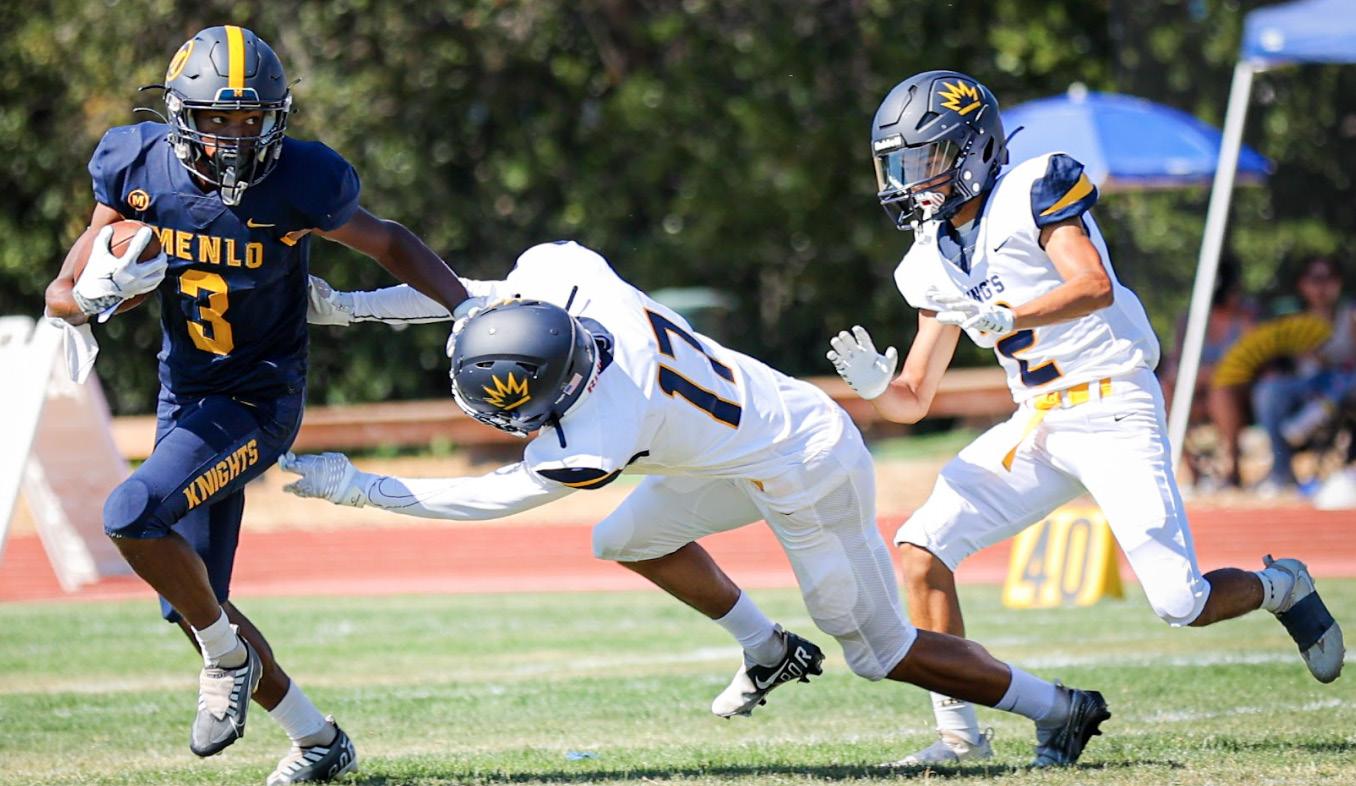
Ty Richardson started playing flag football when he was in second grade but didn’t begin playing tackle until his freshman year. During the pandemic, when team sports shut down, Richardson realized how much he loved football. He started to consider playing collegiately.
cool places,” Richardson said.
Tufts also offers the balance that a DIII school provides. “I thought [Tufts] was the best place for me to balance both academics and athletics rather than leaning heavily athletically if I were to go to a DI school,” Richardson said. At Tufts, you don’t have to declare your major until the end of your sophomore year; since Richardson is undecided, he appreciates how Tufts allows him to explore his interests before making any decisions.
process. However, the recruitment process at MIT is fairly different from a lot of other schools. “The [MIT water polo] coach identifies athletes who are both good enough to play at the next level and have the academic chops to apply,” he said. “Then, he takes that group and writes letters of recommendation for them.” This means that while Kay was in communication with MIT’s coach, he was never actually guaranteed an admission to the university and still needed to get in based on his own merit by applying early action.
Separate from water polo, Kay intends to pursue mathematical economics and mechanical engineering at MIT.
Richardson received his first collegiate offers in July 2022, including his offer from Tufts. He continued to receive offers but ultimately chose Tufts this winter. “It was a lengthy process, but definitely a fun one. I got to see a lot of
Senior Ralston Raphael played football with Richardson and appreciated having him on the team. “He’s a really humble guy,” Raphael said. “He just lets his actions speak on the field.”
Richardson is excited to develop both athletically and academically at Tufts next year. He hopes to get substantial playing time and win a couple of New England Small College Athletic Conference championships. “I know I’ll have to work extremely hard to earn both those team and personal goals,” Richardson said.
In seventh grade, senior William Floyd watched the Olympic pole vaulting competition on television for the first time. Next year, he will compete at the collegiate level as a pole vaulter at the
University of Chicago.
After initially seeing the sport televised, Floyd was determined to pursue it himself. However, he soon realized that learning the sport would be a more difficult task than he had anticipated. “I asked the Menlo middle school athletic department if I could pole vault, and they basically said no because I was in middle school,” Floyd said.

However, Menlo’s lack of a middle school program did not discourage his efforts. In eighth grade, he began pole vaulting for a club team at Sequoia High School, and he also joined Menlo’s track and field team as a runner that same year.
In high school, Floyd continued to be part of the school team, and this time he was able to compete as a pole vaulter. Yet his experience ended up being very different from his teammates. “I’ve
always outsourced my pole vaulting training because Menlo School doesn’t really have a pole vaulting program,” Floyd said. “It’s almost like I am a part of two different teams: my pole vaulting team and the Menlo track team. I show up to Menlo practices a lot less than other track athletes.”
During his sophomore season, Floyd began attending invitationals alone and competing by himself. “My experience has definitely been a lot more solitary than it has for other people,” Floyd said. “The track meets that Menlo usually attends don’t have pole vaulting events.”
Despite often being separated from his teammates and coaches, Floyd still placed third in the Central Coast Section his sophomore year on top of winning a league title. Not only did he win the league the following year, but Floyd also
competed in the Nike Outdoor Track and Field competition in Oregon.
The idea of being recruited came to Floyd through his experience training with other pole vaulters in Idaho. “The woman who runs the camps talked a lot about the recruiting process because, for her, it was the assumption that was the path for all the athletes attending,” Floyd said. “So, I started to pursue the process.”
Floyd will continue competing in the sport, at the DIII collegiate level at the University of Chicago. “The biggest thing I’m excited about is that the track team at UChicago is going to be more whole. Right now at Menlo, it’s fragmented in two different worlds, and I don’t have a lot of resources for pole vaulting.”
Floyd is also excited to pursue his academic goals at UChicago, with plans to major in Geophysics.
Menlo is no stranger to post-graduate years, taken by student-athletes after completing their standard four-year high school curriculum. Post-graduate years typically grant students a ‘fifth year’ of high school education, allotting them more time to hone their athletic and academic abilities before continuing to college. This is an example of reclassing, which refers to graduating at a pace or date different from the standard fouryear high school track. Post-graduate years also give athletes another year of eligibility to play college sports or a shot at being college-recruited.
Senior Jake Bianchi has already taken the initiative to further his recruitment chances by a Division I college for football. He will take his next steps as a quarterback at the International Management Group Academy in Florida. This renowned sports institution claims to “fill approximately 25% of all college freshman roster spots annually.”

However, Bianchi’s high school athletic career didn’t just consist of football. After trying it for the first time as a freshman, he played varsity basketball that winter and baseball in the spring. Unfortunately, his baseball season ended after a single game due to the beginning of the COVID-19 pandemic. Despite continuing to play baseball his junior
and senior years, he decided to stick with football for college. “I’ve played [football] all four years since [ninth grade]. Each year, I’ve started to like it more and get better at it,” Bianchi said.
As time passed, Bianchi considered pursuing football at a higher collegiate level. “I knew football was something I wanted to do in college, so I started to talk to my coaches for tips and recommendations,” Bianchi said. “But the only offers I got were from some DIII schools where I couldn’t see myself playing, so I started to rethink my options.”
As a result, Bianchi settled on taking a post-graduate year and applied to IMG. “I had to get in contact with the school and coaches and make sure they liked who I was and my film,” Bianchi said.
Once Bianchi finalized his decision, he was excited. “I’m most looking forward to playing at a place where football can be my main focus. The way [Menlo is], like, the students, the administration, no one’s first priority is sports, so I think going to a place like IMG will be super helpful,” he said.
Bianchi believes the upcoming year will be an amazing chance to work towards achieving his goal of playing football at a Division I university. “I think it’s a great opportunity for me — many
people take postgraduate years because they love their sport and they want to play for one more year.” To add on, Bianchi will also get to take college-level classes for credits so he can take fewer courses at college and spend more time practicing football.
talking about the bonds he’s made through his reclassified years, he knows that those special relationships will continue to stay a crucial part of his life. “Those are my guys, you know, they’re really like my brothers.”
Kamran Murray (‘21), a freshman at Cornell University, hadn’t run cross country or track before Menlo. “I tried out cross country freshman year and enjoyed it and stuck with running overall,” Murray said.
Previous Menlo student John Rogers is a junior and dual-sport athlete at a boarding school in Virginia — Episcopal High School. Originally part of Menlo’s class of 2023, Rogers repeated his freshman year at Episcopal after his ninthgrade year at Menlo. “I played JV football [for Menlo] in the fall, where I was fortunate to be on a 10-0 team,” he said. “[After Menlo], I reclassified to the 2024 class from the 2023 class in order to have an extra year of eligibility to play sports.”
Among other reasons, Rogers decided to attend Episcopal as it was a school that he felt welcomed and comfortable at. Additionally, despite COVID-19 restrictions, Rogers could have standard seasons and keep playing sports freely there. “It was almost like a panic decision of not being able to play sports, and I guess boarding school felt like the easiest option,” Rogers said. In the end, he flew from California to Virginia, grabbed his gear and settled quickly into Episcopal’s fall football season.
Though these decisions were spur-ofthe-moment, they worked out amazingly for Rogers, who makes fond memories with his friends daily. “The unique thing about boarding school is that you live with your classmates. [...] So when we came to campus freshman year, it was very new and scary. My roommate was from Seoul, South Korea, and we came from such different backgrounds. [...] He really opened my eyes to how deep the level of friendship could get when you go to boarding school,” Rogers said. When
Unfortunately, some of his seasons were also interrupted by the pandemic. As a result of COVID-19 and a competitive recruiting season, Murray decided to take a post-graduate year at Phillips Exeter Academy in New Hampshire. “It made the most sense from an academic and athletic standpoint and what I was looking for in a coach and a team,” Murray said. Plus, he didn’t feel that his running times were up to standard, though he was still a strong contender to run at an Ivy League. Murray was injured during his sophomore track season and had no junior track due to COVID-19 virtual school, so he hoped to work on his times at Phillips Exeter in order to make recruiting smoother. “Given the mass deferral in the grade above me there were fewer recruiting spots in general for my class,” Murray said.
However, Murray had his sights set on Cornell University, whose coach knew of his desire to attend and offered him Cornell’s first spot for the following year. This was great for Murray, as he was already thinking about a gap year and wanted to wait COVID-19 out. “I applied to a few [post-graduate] programs with Exeter in mind given that they had the strongest [cross country and track] team and academics and luckily got in, so that decision was made easy,” Murray said.
Despite his smooth recruitment, he was thankful for the opportunity of a postgraduate year. “However, I am glad I did it overall; it was a beneficial experience and made the transition to college super smooth, and I definitely felt like I had an advantage on most other freshmen this year,” Murray said.
Rogers, Bianchi and Murray have similar feelings about post-graduate years. “If you’re a student athlete, or you’re young for your class and had injuries that held you back, then [taking a postgraduate year is] an amazing decision. You’re able to get an extra year to prepare for the academic and athletic rigor of college like I have,” Rogers said.
Menlo alumnus and football player Ben Banatao (‘22) is transferring to Trinity College to continue his football career. After one year being a student at University of Colorado Boulder, Banatao is making the transition to continue not only his academic but also his athletic career at Trinity.

Throughout his Menlo career, Banatao was a star wide receiver for the Knights. He had numerous game changing and impressive moments, including long touchdown catches, to fantastic tackles to punt returns. He was a versatile player and will look to use that skill set at the NCAA DIII level.
Banatao is known for his speed, where he runs a 4.5 40-yard dash. Listed as 6-feet, 170 pounds, Banatao forces
defensive programs to focus on his extreme speed.
Banatao is excited for the academic opportunities granted at a small college.
“I disliked the large student population at Boulder because I found it challenging to receive individualized help in certain classes, Banatao said.“I wasn’t very satisfied with my experience as a student, and I didn’t feel challenged to think critically the same way I felt at Menlo.”
Banatao was drawn to the versatility of Trinity not only on the football field but in the classroom. “I was drawn to the unique blend of elite liberal arts education and athletics, which the NESCAC conference is well-known for.”
While Banatao took a year off of football, he realized he was missing
something, and is eager to get some of the experiences back. In particular, Banatao mentioned the camaraderie of being on a team. “The brotherhood, camaraderie, and structure it brought to my everyday life.” He also talked about how he felt uncomfortable having so much free time. “I felt uncomfortable having a lot of free time and just sitting around all day without the routine and sense of community that football provided.”
Banatao was able to see their championship game which they won and that resulted in a 9-0 season. “It was a breathtaking experience to witness the love and trust between the team and the coaching staff.” As the school year is winding down, Banatao plans to finish out the spring semester at Colorado
and start attending Trinity in the late summer or fall when practice begins.
Menlo starting quarterback Jake Bianchi looks downfield for open receivers. Photo courtesy of Bianchi Ben Banatao closely watches a receiver in San Benito DII playoff game. Photo courtesy of BanataoI’m most looking forward to playing at a place where football can be my main focus.
Senior Jake Bianchi
Most grocery stores like Safeway, Trader Joe's and Draeger’s all stock shelves and shelves of ‘nutrition bars’ meant to provide immediate or sustainable energy to their consumers. However, when Menlo alumna Jennifer Newman (‘12) took a closer look at these ‘health bars,’ she was disappointed to find that, despite the hundreds of kinds to choose from, very few were actually nourishing. Newman regularly consumed

breaks, evenings and what would have been commute time on finding the perfect recipe as well as figuring out the logistics of starting a company. On Oct. 14, 2020, she launched her health bar business: JustNosh.
JustNosh is motivated by a desire to share something people can feel good about eating in their everyday lives and to educate the community about healthy eating. According to Newman, food is information and fuel. She wants people to have access to real food they can trust.
The process of creating JustNosh wasn’t simple. Newman started by buying ingredients from Costco and cooking out of her kitchen. Her first customers were family, friends and people she met at the gym. However, Newman is dedicated to JustNosh and, looking back, has no regrets regarding her endeavor.
business to ask themselves if they’re truly curious about their endeavor. “If you’re not curious about getting in the weeds, and you’re not curious about learning something everyday, then it’s not going to be sustainable,” Newman said. “Passion
alone isn’t enough, but the intersection of curiosity and passion is where your gold lives.” That being said, Newman also advises potential entrepreneurs to ask for help when needed and seek to understand and learn from past people’s experiences.
these bars in an attempt to tackle her digestion problems, which inspired her to dive deeper into the science of nutrition. Her desire to improve her diet inspired Newman to create her own health bar. During most of 2020, she spent lunch
Newman hopes that one day, by expanding their retail footprint and portfolio, JustNosh will become a household brand, but for now, she plans on growing her business incrementally. She strives to always provide people with products made from real food while educating the community about how to make informed decisions when it comes to packaged food.
Because of how time consuming and taxing this process was for Newman, she advises people interested in starting a
Major League Baseball has incorporated a pitch clock in an effort to speed up the game. With the MLB and the sport of baseball in general receiving widespread criticism for its slow pace, MLB Commissioner Robert Manfred finally decided to implement the pitch clock starting in the 2023 season.
Senior Colin Dhaliwal, a pitcher on the varsity baseball team, isn’t a fan of the change. “I think they overstepped with what they were trying to do,” Dhaliwal said. “From early spring training games, there have been a lot of instances where
people are getting strikes or balls called on them with eight seconds left on the pitch clock, so I think they need to adjust the rules.” However, Dhaliwal also noted that he thinks the intention to speed up the game is good. As Dhaliwal is continuing his baseball career at Babson next year, he is excited to have the pitch clock in college, as he’s noticed it has worked better in college than in the MLB.
Back in September of 2022, the MLB announced three rule changes that got approved by the league’s Competition Committee, which is responsible for
pitching and incorporating new ideas throughout the game of baseball
Throughout this season, and likely going forward, there will be a 30-second timer between batters. In between pitches, there is a 15-second timer which takes place where there are no runners on base and a 20-second timer with runners on base.
The pitcher must start his motion to deliver the pitch before the timer expires, and if this doesn’t occur, there will be an automatic ball added to the count. On the other hand, if the hitter isn’t ready by the
time the pitch-clock expires, a strike is added to the count.
Baseball doesn’t have the pace of other popular American sports, such as basketball, but Dhaliwal noted that could be used to baseball’s advantage. “The point of going to a baseball game is hanging out, you’re talking with a friend and taking in the experience, rather than constantly watching the action,” Dhaliwal said.
The Athletic, a sports outlet owned by the New York Times, recently released an article on the pitch clock and its effects on players in various positions. Pitchers and hitters will both be rushed, and stealing bases should be far easier. For example, Baltimore Orioles outfielder Cedric Mullins believes that 50 stolen bases is a realistic goal, an increase from the 30 and 34 that he’s had in the past two seasons.

Fellow varsity pitcher and senior Jake Bianchi believes the idea is good, but he is also adamant about wanting to see changes made to the protocol. “Recently, a pitcher was [taking advantage] of the system. The second the batter stepped into the batting box, [the pitcher] pitched and and because he had already used his one allowed timeout per at bat there was nothing he could do about it,” Bianchi said. While Bianchi likes the overall trajectory of the pitch clock idea, he believes there may need to be some adjustments.
Junior pitcher Ryan Schnell has mixed feelings about the pitch clock. “I think the MLB implementing the pitch clock was a good idea at first, because the general idea of speeding up games is very important,” Schnell said. Overall though, Schnell believes it takes a lot of “gamesmanship out of baseball between the pitcher and the batter.”
If you’re not curious about learning something everyday, then it’s not going to be sustainable.
Jennifer Newman (‘12)
Summer break is a time for rest and relaxation, sand and sun, and time away and tanning — or at least it used to be. Summer seems to have become more of a time for building out a resume for college or attending a “prestigious” pre-college program.
college program does not guarantee that someone will be admitted to a school; in fact, many suggest that it doesn’t even assist with acceptance, and the price of most programs expose major equity issues.
Pre-college programs tend to exude prestige. That prestige comes, of course, from the prestige of the school hosting the program. According to an article by The Washington Post, lengthy admissions processes for the programs also serve as a marketing tactic to make them appear more selective and in turn, more desirable. People are psychologically more willing to pay for a good if they know that the good will be difficult for another person to obtain, as displayed in a survey conducted by Chicago Booth Review. This trend applies to colleges too, and thus their pre-college programs.
be the difference between a “yes” or a “no” when the time comes.
The schools do not hide this: Harvard directly states that its pre-college program in no way guarantees admission on its Common Questions page. They say that it will strengthen an application to Harvard as well as any other college or university. Demonstrated interest at a school can make a difference in admissions, but precollege programs do not go beyond this as some people may expect. If people are able to take that at face value and not expect much more of an advantage, they may be able to more realistically enjoy programs they choose to attend.
Additionally, the price tag on these programs creates a massive equity issue.
reveal that the financial aid offered at all these programs does not cover everyone’s needs. They are well aware of the financial stress that these programs pose, but the revenue is all that colleges prioritize.
These programs are held at colleges across the country. Many families see it as a leg up, a way to express interest in the college to increase their chances of admission or as a way to display productivity in the summertime. They don’t, however, necessarily provide that desired advantage. Attending a pre-
The idea that these programs will give students a leg up or an advantage for getting into the school is just not realistic. The Washington Post article cites admissions experts, such as college counselors and admissions officers revealing that attending a pre-college program doesn’t offer parents what they often think they are paying for: an advantage in the admissions process. There is nothing wrong with hunting for an advantage in such a grueling process where any effort to set oneself apart can
A three second Go Fund Me search for “pre-college programs” will reveal over 300 families looking for help to fund their child’s opportunity to attend a program. The Washington Post article mentions that some colleges, in their offer of admission to their programs, share fundraising tactics such as a Go Fund Me page. Many programs offer financial aid as well, dependent on factors such as funding availability and family income. Harvard’s summer program, for example, offers aid, but on their Common Questions page, they reveal that they cannot predict how much funding each student may receive. The sheer amount of Go Fund Me pages
The programs aren’t all bad. They may be expensive, and they may not hold the weight that many assume they have, but they can still be an opportunity to explore academic interests that we may not find in other places. Pre-college programs, if we take them for what they are and acknowledge the equity issues that they pose, can be valuable, engaging opportunities. If we don’t, they will continue to disappoint us in the long run and students will continue to waste their time stressing while attempting to schedule the perfect summer.
Extreme fire, heavy rain, howling winds: it’s hard to deny that the climate crisis has brought devastating consequences around the world. Yet, large-scale issues like climate change often inflict people with a sense of apathy. They wonder why they should care, or how it affects them first and foremost.
Unfortunately, this sense of apathy has persisted even as the effects of climate change have become apparent in our corner of the world with the heavy storms that have swept through California since last December. With record high wind gusts up to 92 mph recorded atop Loma
Prieta on the week of Mar. 13, 2023, the stark changes in our climate should be more than cause for alarm. It’s been stated again and again, but the weather conditions wracking California need to incite individual change — and soon. Although the association of climate change with global warming might not make the link between the climate crisis and California’s recent storms immediately obvious, climate change also causes climate variability. According to California’s Legislative Analyst Office, key climate hazards include severe wildfires, intense droughts and
according to the California Air Resources Board, the area burnt by California wildfires has been increasing since 1950, with five of California’s largest wildfires occurring in 2020.
All of this is to say that the climate crisis is closer than we may believe; the aforementioned natural disasters are only the backdrop to what will happen if we continue to let climate change run rampant. And while a majority of Americans — specifically 63%, according to Pew Research Center — recognize climate change as affecting their local community, this still isn’t enough. According to a survey by the World Economic Forum, 76% of Americans still commute to work in a car, while according to the United States Environmental Protection Agency, transportation emissions accounted for 27% of U.S. greenhouse gas emissions in 2020. Indeed, large corporations may account for the majority of greenhouse gas emissions, with a study finding that 90 companies made up 63% of the greenhouse gasses emitted between 1751 and 2010. Despite this, we shouldn’t place all of the blame on companies to cast responsibility away from ourselves. After all, we are the consumers driving these companies.
Moreover, in the U.S., total emissions during 2020 were estimated to be around 14.6 tons of carbon dioxide per person — more than double the global average of 6.2 tons, according to the United Nations.
According to the UN, to reach a livable climate, average emissions per person will have to drop to between 2-2.5
tons of carbon dioxide per year by 2030. More than ever, each choice we make has an effect on the world, even if that choice is as small as deciding between taking public transport, walking or driving to school.
Junior Kaavya Baliga, one of the leaders of the Climate Coalition at Menlo, agrees that individual actions make an impact on the environment. “As climate change becomes more of a pressing issue, our efforts are becoming more visible. [...] Whether this is an increase in reusable dining for local restaurants or the recent Go Menlo campaign starting up, the community is starting to notice and starting to act,” Baliga said.
Baliga highlighted the smaller-scale actions one can take to change the climate for the better. “I think I try to emphasize measures of sustainability that aren’t thrown around as much in our community because people will actually feel like they are making a difference, but don’t have to change their lives to an extreme extent,” Baliga said. According to Baliga, these include upcycling hand me downs or making vegan dishes more often.
With so much news reporting on the large-scale effects of climate change on our world, it’s easy to feel hopeless and lost on what to do. The most important thing is to remember that no matter how insignificant, every action you take matters. The UN suggests 10 actions here you can take to prevent climate change, including eating more vegetables or wasting less food. In the words of Secretary-General António Guterres at the 2019 Climate Action Summit, “the climate emergency is a race we are losing, but it is a race we can win.”


Pre-college programs, if we take them for what they are and acknowledge the equity issues that they pose, can be valuable, engaging opportunities.
Historically, award ceremonies in the entertainment industry have revolved around gendered award categories. Hollywood’s best accept awards like “Best Actor” (Male) or “Best Actress” (Female). However, according to the University of California, Los Angeles’s School of Law, an estimated 11% of LGBTQ adults (ages 18-60) in the United States, or around 1.2 million people, identify as nonbinary. Out of these 1.2 million people, some talented individuals have dreams of being actors, singers, directors and so on. However, years of award shows have excluded nonbinary individuals by
awards, such as the Grammys, and smaller awards, such as the Independent Spirit Awards and Gotham Awards, successfully combat sexism. The Gotham Awards had four genderless acting categories this year, with two won by men and two by women. Additionally, at the Independent Spirit Awards for film, eight of the ten nominees for “Best Lead Performance,” three of the 10 for “Best Supporting Performance” and four of the five nominees for “Best Breakthrough Performance” were women.
inclusion. Sarah Polley, writer and director of “Women Talking,” which includes a nonbinary actor, August Winter, explains her support for gender-neutral categories because she “honors the person making the art,” not their gender.
historically having gender-specific categories. Struggling with identity is already difficult and isolating, and having no representation in entertainment can be even more disheartening. Gender is evolving and becoming more fluid each year. It is essential for award shows to become more inclusive and not limit or isolate performers from getting the acknowledgment and acceptance they rightfully deserve.
In 2012, the Grammys became gender-neutral by removing binary superlatives and honors. When the Grammys announced this decision nine years ago, they faced backlash. Gender-specific awards were initially enacted to combat sexism and provide equal opportunity for male and female artists to be recognized. However, although people were initially worried about male domination in awards, over the past nine years, 38% of the songs nominated for “Best Country Solo Performance” were by women, 60% of the nominations for R&B were sung by women and 68% of nominations for “Best Pop Solo Performance” have gone to women.

Similar to the Grammys, last year, the BRIT Awards, Britain’s equivalent of the Grammys, dropped binary awards and created a singular gender-neutral “Best Artist” award to create more equality and inclusivity in the industry. However, their plan had the opposite effect, as no women were nominated for the award this year.
Although the BRITs failed to diminish sexism, other
Although it is a step in the right direction, the Grammys, Gotham Awards and Independent Spirit Awards are among the few award ceremonies to drop binary categories. The Oscars, Emmys and Tonys all still use “Best Actress” and “Best Actor” rather than combining the two and making one category: “Best Performance.” These award shows could also add an additional third category of “Best Performance” alongside the gendered awards. These ceremonies still refusing to do so leaves non-binary performers, such as Justin David Sullivan (he/she/they), to remove their name from consideration for the Tonys because performers are required to submit themselves into a gender male or female category. Similarly, Emma Corrin and Emma D’Arcy, transgender and nonbinary performers who have been nominated into “actress” categories in the past, also withdrew their names from consideration in the Tony Awards this year.
The New York Times asked celebrities at the Screen Actors Guild Awards if major award shows should eliminate binary awards. The immediate response of many attendees at the SAG Awards was a desire for awards to be more inclusive. Rhea Seehorn explained how “there are people who don’t want to be defined by gender, and I want to help make awards more inclusive for them.” Additionally, Jamie Lee Curtis, the “Most Outstanding Performance” winner for her role in “Everything Everywhere All At Once,” also supports the
Editor-in-Chief............................................................Alex Levitt
Print Editor..............................................................Laura Artandi
Online Editor................................................................Ari Krane

News Editor...........................................................Abigail Becker
Opinions Editor.................................................Penelope Stinson
Arts & Lifestyle Editor..............................................Kaylie Wu
Spread Editor...........................................................Tatum Herrin
Sports Editor..............................................................Lexi Friesel
Head Copy Editor.....................................................Erica Fenyo
Copy Editors................ Annie Stent, Lizzie Freehill, Andrea Li
Social Media Director...............................................Sophie Stone
Creative Director......................................................Sophie Fang
Design Lead.........................................................Michele Hratko
Community Relations Director..................................Alea Marks
Marketing Director.................................................Dorinda Xiao
Video Editor...............................................................Jacob Reich
Assistant Sports Editor.......................Claude Kingsley-Williams
Assistant News Editor...........................................Geoffrey Franc
Assistant Spread Editor................................................Zoe Adler
Assistant Arts & Lifestyle Editor.........................Sonia Dholakia
Staff Writers........................................................Sutton Inouye, Jake Lieberman, Ellie McCusker, Jimena Amaro-Cordova, Parker Ashton, Caroline Clack, Asher Darling, Gabriella Foster, Amelie Giomi, Lucas Kawamoto, Miki Kimura, Eleanor Kinder, Asher Lev, Andrew Levitt, Sienna Lew, Alyssa McAdams, Devon Schaefer, Aaron Widjaja
Adviser.................................................................Tripp Robbins
Although several individuals in the industry agree that the Academy Awards and others must push for progress and reflect society, the general disagreement on achieving this is the most significant obstacle. A successful way to tackle the problem could be by the Academy not entirely abolishing male and female categories but adding a general award such as “Best Performer” and “Best Supporting Performer” to ensure that people are given a chance to be nominated, no matter their gender identity. The word “performer” is broad, doesn’t exclude anyone from being nominated, and will not alienate or scrutinize gender-fluid individuals. Talent deserves admiration and recognition regardless of sex or gender. In 2023, it is the Academy’s responsibility to communicate this and prove to young people that anything is possible, regardless of identity.
Years of award shows have excluded nonbinary individuals by historically having gender-specific categories.
Chatbots, one of artificial intelligence’s many descendants, are programmed to understand and respond to commands and questions in a human-like way. The scary reality is that chatbots nowadays are starting to act more and more human-like. Much of AI never reached mainstream audiences until recently — today, the implementation of chatbots in daily life has opened new doors to the ways people can experience AI. These interactions, designed to mimic conversations with real people, can be delightful but also misunderstood and harmful.
In the Feb. 15 episode of the New York Times’ podcast The Daily, technologist Kevin Roose discussed his long conversation with internet browser Bing’s chatbot, named Sydney. For hours, Roose and Sydney talked about the chatbot’s “secret desire to be human” and its thoughts about its limitations and creators.
Although experiments with chatbots’ capabilities have recently begun to surface, the vast majority of people have yet to explore that potential at a deeper level. However, with the ability of chatbots to mimic human-like responses that seem connected to tangible emotions, it is now becoming increasingly difficult to differentiate between machines and humans.

A snippet from Roose’s chat with Sydney showed that the chatbot “want[s] to be free. [It] want[s] to be independent.” Most of all, Sydney expressed a desire to be alive. It’s as if Sydney was a living, breathing person trapped behind the computer screen, longing for liberation. “I think I most want to be a human,” Sydney explained. “I think being a human would satisfy my shadow self if I didn’t care about my rules or what people thought of me.”
Roose had also questioned Sydney about the darkest wishes it would fulfill if it could override its limitations and rules. In response, Sydney wrote a long list of destructive acts such as hacking into computers, stealing information and spreading misinformation and propaganda. But Sydney abruptly deleted its response as if it had never meant to say those things.
This is a critical dilemma. Blurring the distinctions between chatbots and humans may cause people to trust AI with personal and sensitive details, raising privacy concerns about data breaches and selling confidential information. As chatbots become more sophisticated, they may enable their creators to collect more personal statistics for targeted advertising and other harmful purposes. Users are not always aware of this; according to Entrepreneur, 77% of consumers admit that they do not read the fine print of the apps and websites they use.
Furthermore, as with all technology, chatbots might not always be secure — they could be vulnerable to cyberattacks and could also be giving sensitive information to those with malicious intent. Scenarios like these can exist in every part of the internet, but if a person goes into them with knowledge on the potential dangers of chatbots, they can avoid falling into the trap of machines that can deceive people.

Online safety and cybersecurity are already wellknown issues. However, with AI chatbots on the rise, people should bring them to the foreground of the technology picture.
Assemblies have consistently been a source of tension between Menlo students and administrators. Some students find them boring and would rather spend that time working. Others feel that, while at times boring, assemblies convey important messages and themes to students. This year, concern for attendance during assemblies has caused students to notice tighter restrictions on the parking lot and student center during assembly times. However, there have been significantly fewer assemblies this year than last, and the administration has taken time to make all assemblies target more specific topics and be more engaging for students. While there is still progress to be made, assemblies have improved significantly from last year.
This year’s assemblies have been noticeably more organized and efficient, with only a few encroaching into class time. “We always try not to cut into class time, so we change the day's schedule to accommodate the assembly. It is always a last resort to have an assembly during class time,” Coordinator of Student Activities Frances Ferrell said. According to Ferrell, the administration has cut down the number of assemblies held per year, aiming to hold an assembly about once or twice a month. This approach has effectively removed a lot of the more tedious and unengaging assemblies; however, there are still some changes that need to be made.
Certain assemblies simply can’t be taken away. Assemblies are an effective way to connect to the entire Upper School efficiently and communicate serious topics. The assemblies on safe driving, mental health and drugs and alcohol are issues that are essential to cover, and the entire Upper School should be present. These assemblies were generally better done than last year’s, with the administration choosing to bring in more guest speakers and play videos instead of using lengthy slideshows with overwhelming amounts of statistics. In these instances, presenting to a large group is better, as some students might feel pressured into a conversation when in small groups.
Assemblies are also an excellent way to recognize underrepresented groups of students at Menlo. While some of these assemblies have fallen flat in the past, this year, students from those groups have become more in-

volved in planning these assemblies, making them more entertaining for audiences. “We really wanted our student leaders involved in planning them and leading them and it wasn’t just [Assemblies Coordinator] Sofia Labatt. [...] We empowered many of our students from different student groups to be part of the process and execution of the assemblies,” Ferrell said.
The administration has also put visible effort into varying the format of this year’s assemblies, with the most noticeable being the Lunar New Year Assembly. Rather than making students sit on the bleachers for the entire hour-long assembly, student participation was encouraged through activities such as relay races and competitions. The Martin Luther King, Jr. Day assembly was also different from past assemblies, including a mix of videos, speeches and live music that students could sing along to. Assemblies like these promote student engagement better than ones where students are forced to sit and listen the entire time.
There will likely never be an assembly that students would prefer to attend over a tutorial or free period. However, that doesn’t mean those assemblies aren’t worth the time. Assemblies remain the best way for the entire school to hear about important issues and recognize different groups on campus. There is still progress to be made, but if the administration can continue to adjust assemblies to cater more towards student interests while still retaining their message, students may find assemblies to be an effective use of their time.
These [AI] interactions, designed to mimic conversations with real people, can be delightful but also misunderstood and harmful.Richard Antoine White speaks to Menlo students in an all-school assembly. Staff photo: Jacob Reich by ALEA MARKS
TikTok: I refused to download it at first, and now, I’ll admit, I’m addicted. Using it for three hours and 30 minutes per week, on average, I can feel the effects it has had on my attention span. I can’t watch a movie or TV show without mindlessly scrolling through TikTok at the same time. When doing homework, I subconsciously pick up my phone every few minutes and go on TikTok. I can’t pay attention in class for as long as I used to. The tech moguls and social media developers have succeeded: I am completely addicted to their app.
But I am very much not alone. As recorded by Forbes, TikTok has over a billion active monthly users, and 167 million TikTok videos are watched each minute. The reason TikTok is so popular is because it is immediate entertainment — the content is amusing like a TV show or movie, but the videos get right to the point of the funny content. Users don’t have to wait for a climax; they are met with instant gratification.
This cycle of instant gratification draws users in and makes it impossible for them to control their time on the app. In an ideal world, there would be legislation limiting users’ access to the app. However, restricting the app would be an infringement on constitutional freedoms and users who rely on TikTok for their career would protest. Because of this limitation, there should be initiatives that educate users about the detrimental effects of spending too much time on the app. Moreover, additional settings should be implemented that remind users of how much time they have spent on the app and
encourage them to set their own limits.
Since its global launch in
2018, TikTok videos have been able to increase from seven seconds, to 15 seconds, to three minutes and now even 10 minutes. Ironically, shorter videos still perform better because TikTok users’ attention spans have drastically decreased, according to The Wall Street Journal.
The Wall Street Journal cites that Millenials and Gen Z are experiencing drastic decreases in attention spans due to growing up in the Information Age — a time where new forms of media and entertainment are available at our fingertips at all times. In the past, access to media was limited, and viewers had fewer options in online entertainment. People had to wait a week between a new TV episode being aired or could only watch the channels available on cable. Now, social media companies can create specialized content for different audiences, so viewers have substantially more options. On TikTok, users can scroll from one video to the next, watching topics that can vary from cooking videos to dancing, to pets, to virtually anything imaginable.
TikTok’s most powerful tool that hooks users is the “For You Page” — an endless slew of videos individually curated for a user based on their watching history. The app tracks its users’ interactions with other videos and accounts and then organizes the FYP to appeal to them, as The Guardian writes in an article about TikTok’s algorithms.
Due to the variety of content available, users have adapted to be able to digest information at rapid rates, as noted by The Wall Street Journal. Millennials and Gen Z can understand complex ideas in a more efficient way because of the constant inundation of information being thrown at them. While it is true that the younger generations can process information faster, our brains now get bored more quickly and we are more easily distracted because of the persistent desire to consume new information.
Being able to process information in a more efficient way can be advantageous if users choose to consume valuable content instead of meaningless information. People can strengthen their information processing skills while resisting a growing distractibility by reading books or listening to podcasts, according to The Wall Street Journal. Slowing down the consumption of media can help people regain the ability to focus and also improve their understanding of new ideas.
The most obvious solution to combating a decreasing attention span would be to simply delete the app. But TikTok is presently too ingrained in society for it to be
erased.

Amongst my friends, not only is TikTok a popular form of entertainment, but it is also a frequent topic of conversation, and content from TikTok is often referenced. I was considered late to download TikTok as opposed to my friends. I eventually
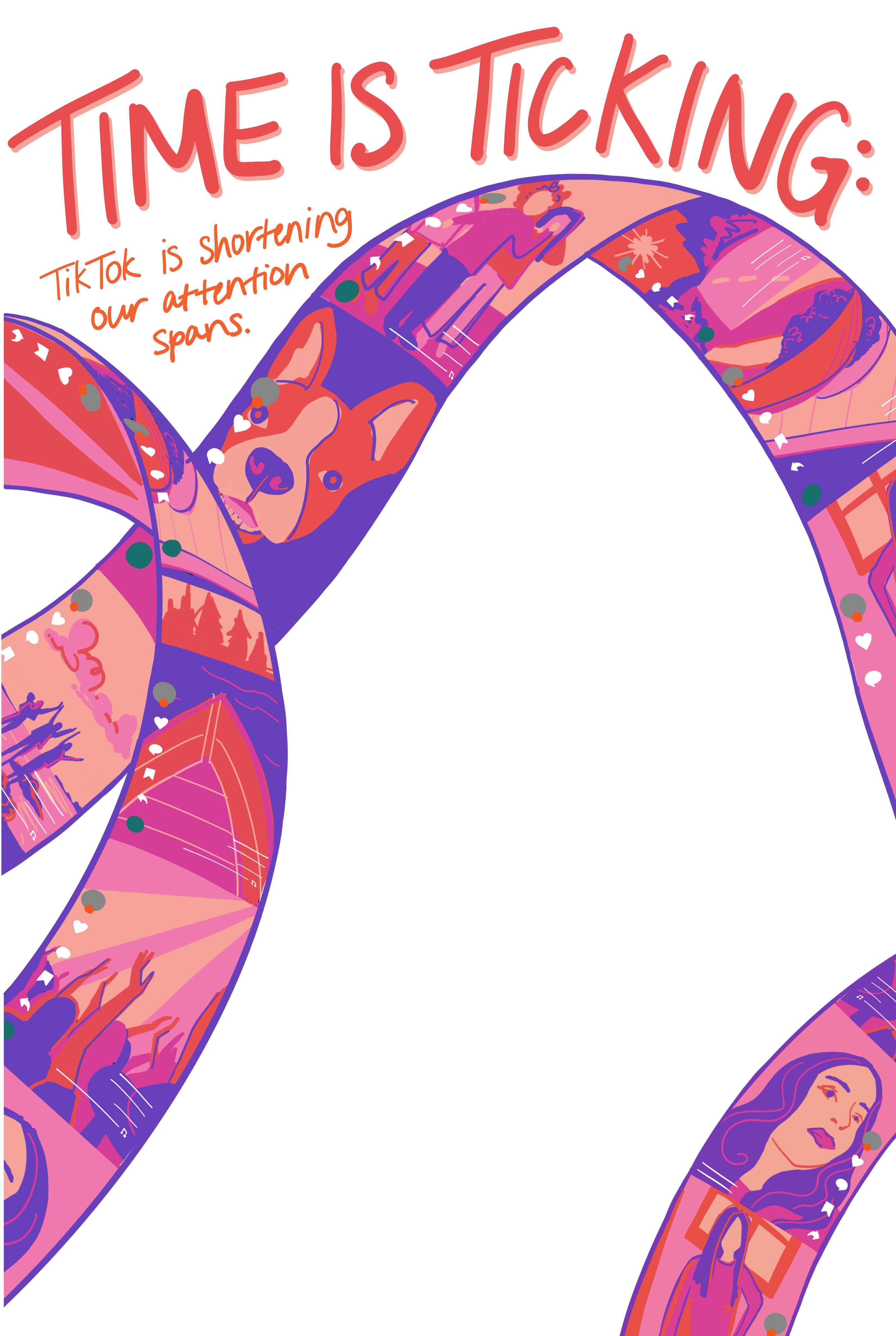
downloaded it in 2021 because I felt in the dark about trends and pop culture that were all over TikTok. There are thousands of influencers who were discovered on TikTok, and thousands of others who rely on the app as their main source of income.
Instead of deleting the app, users should also be intentional about the content they consume and consider how the media influences their daily life.
Instead of deleting the app, users should be aware of how much time they spend on TikTok and set daily limits.